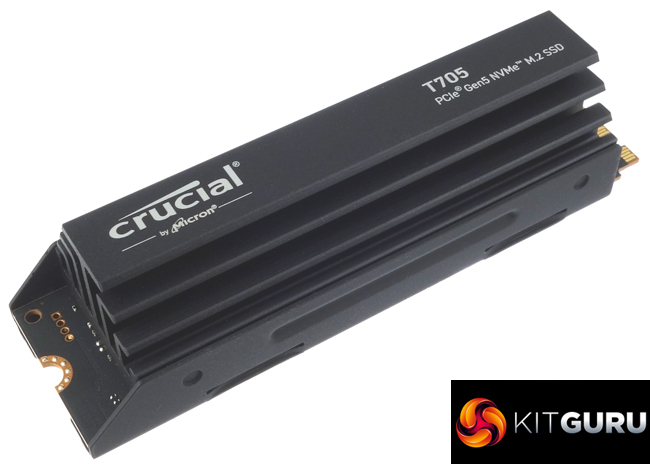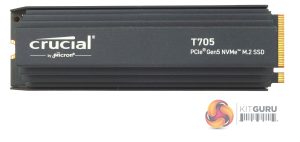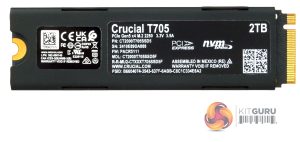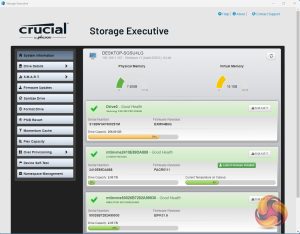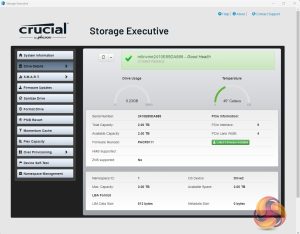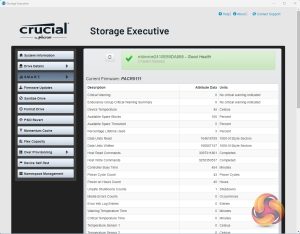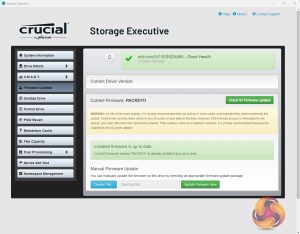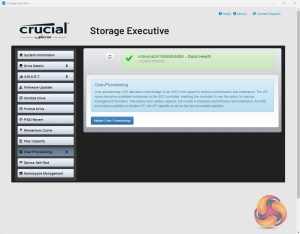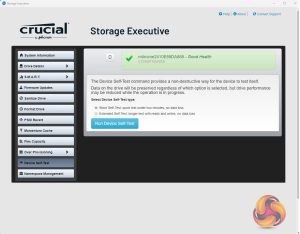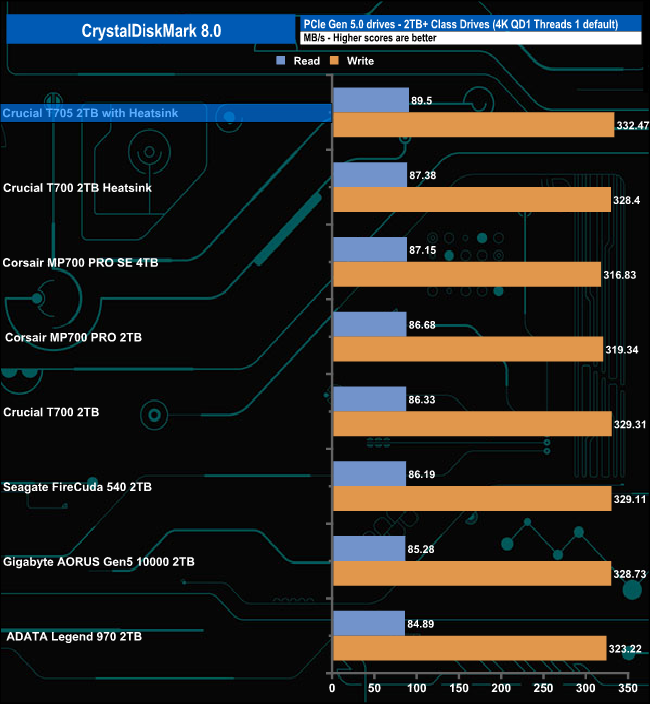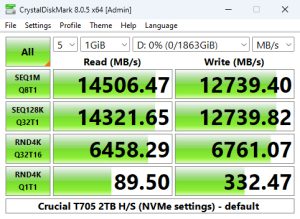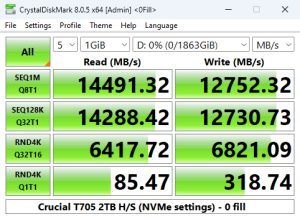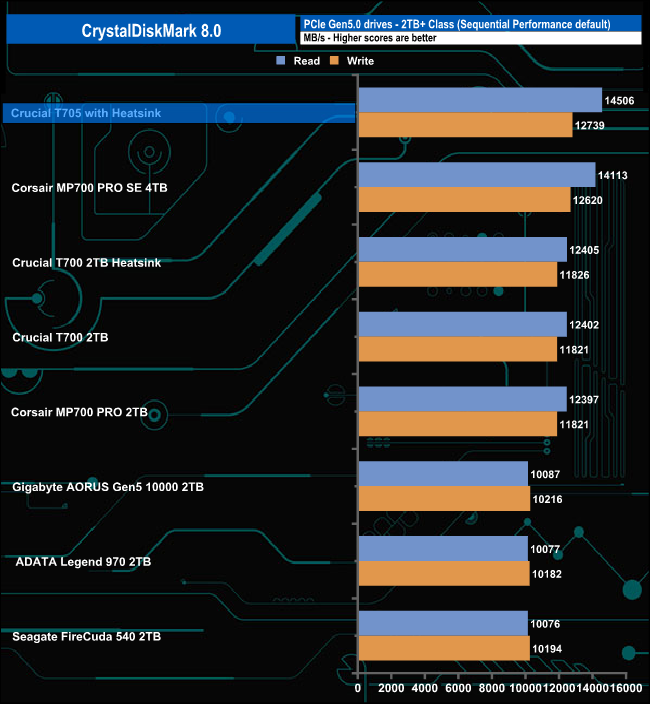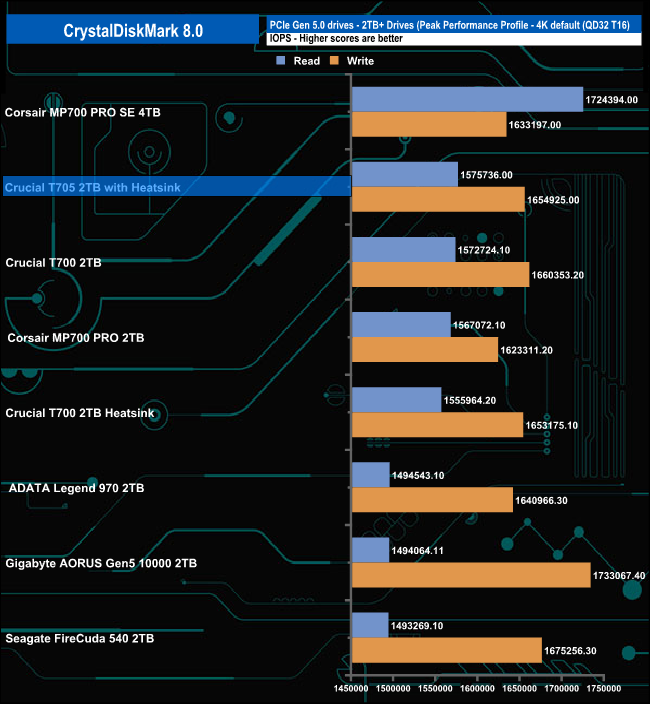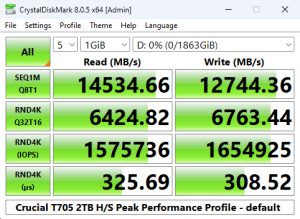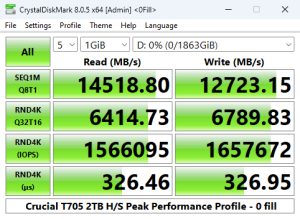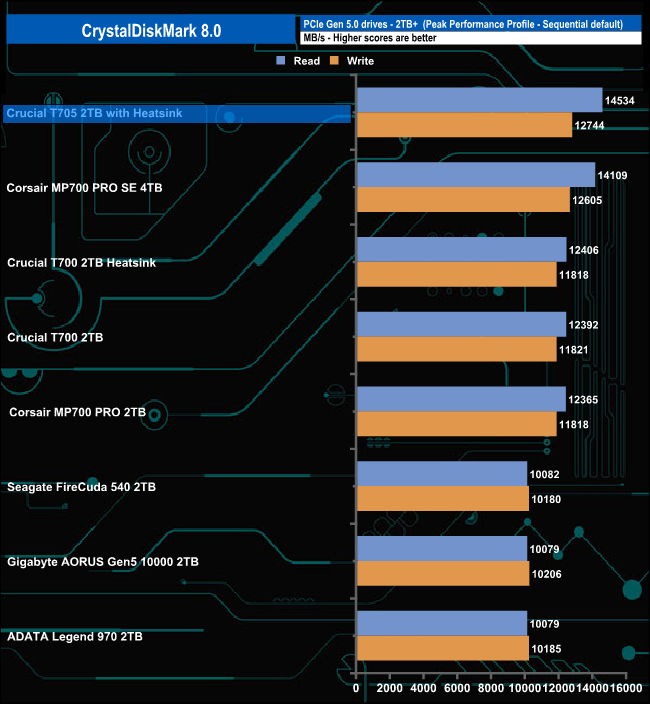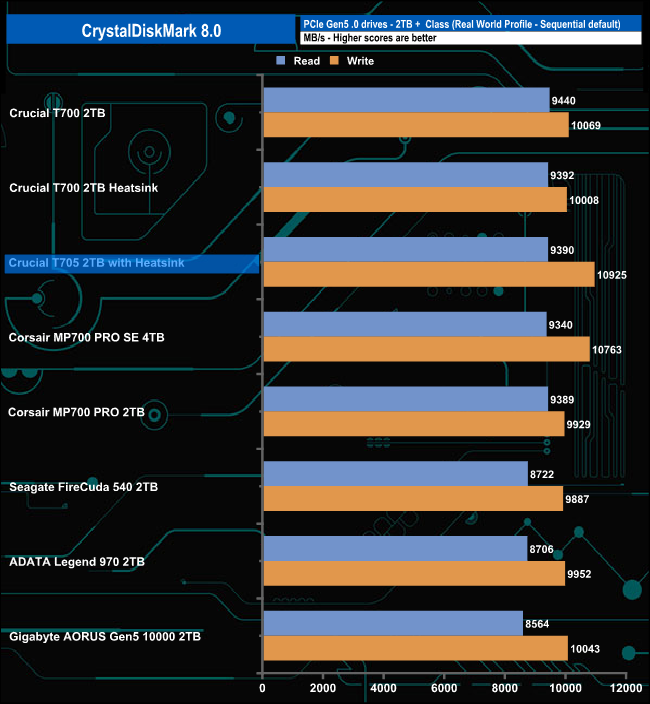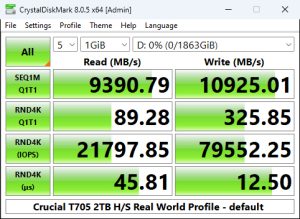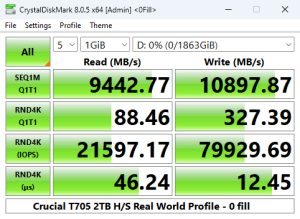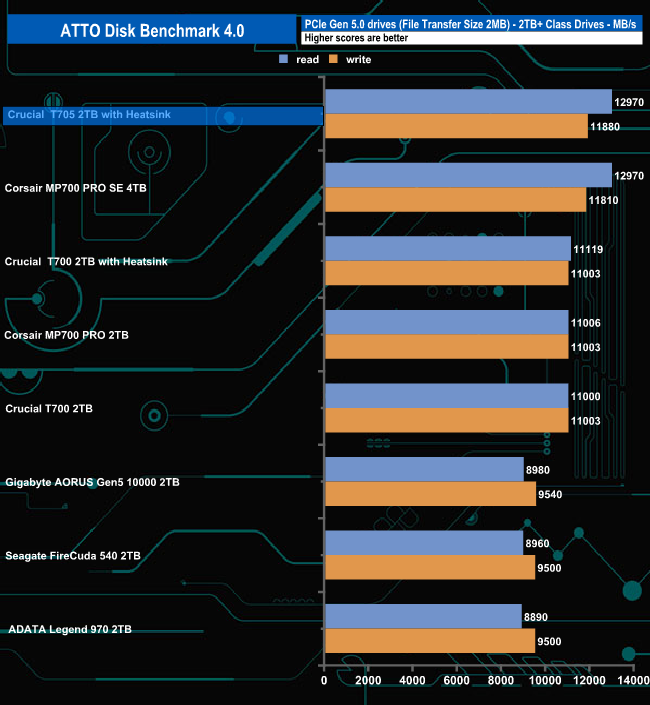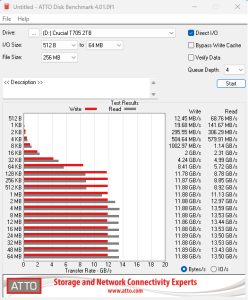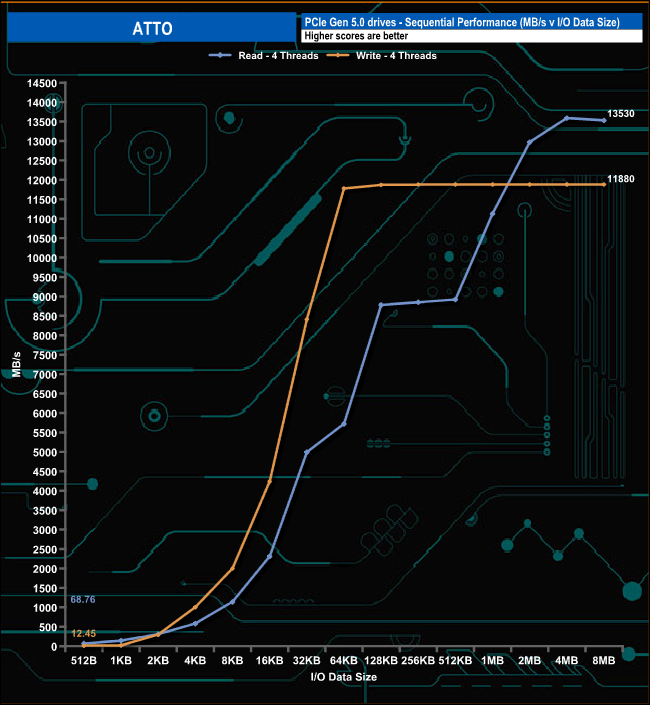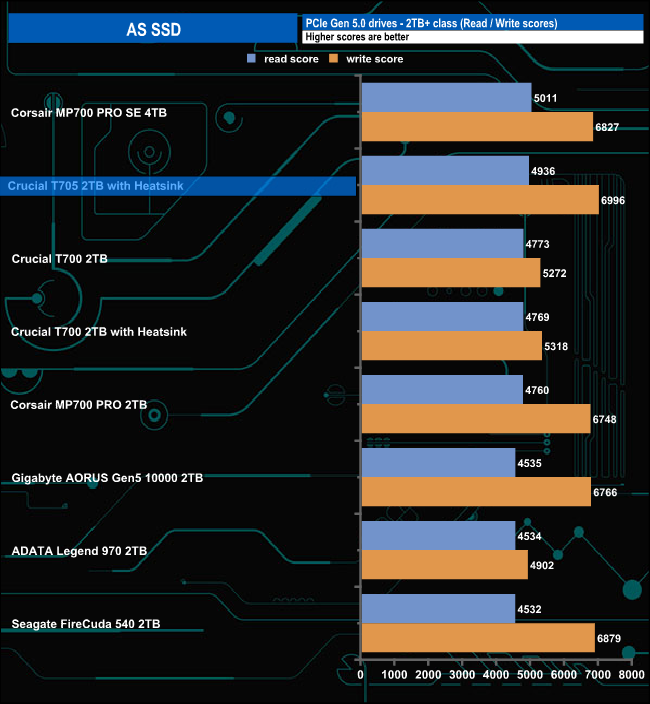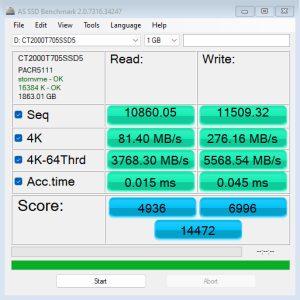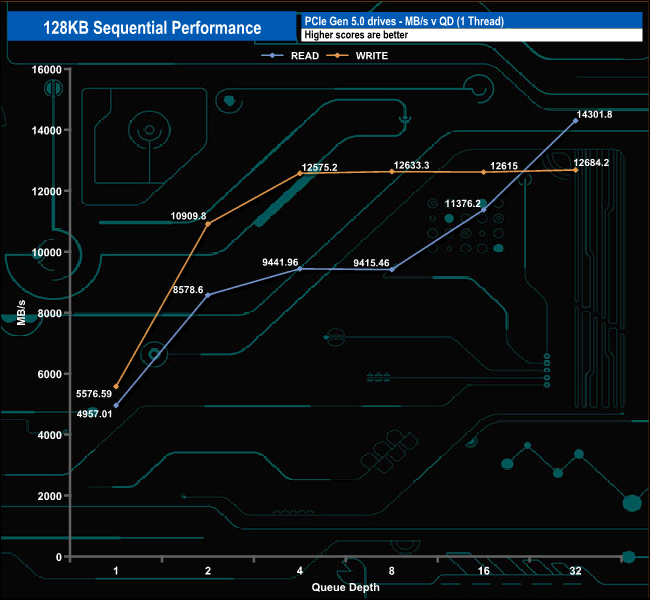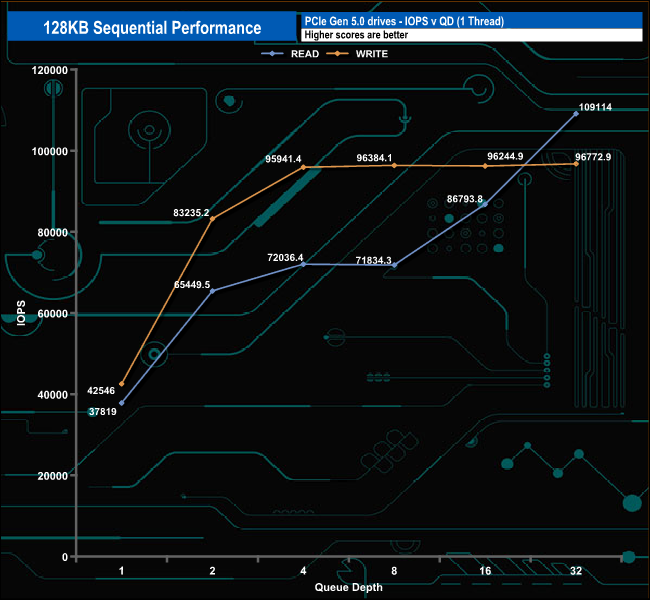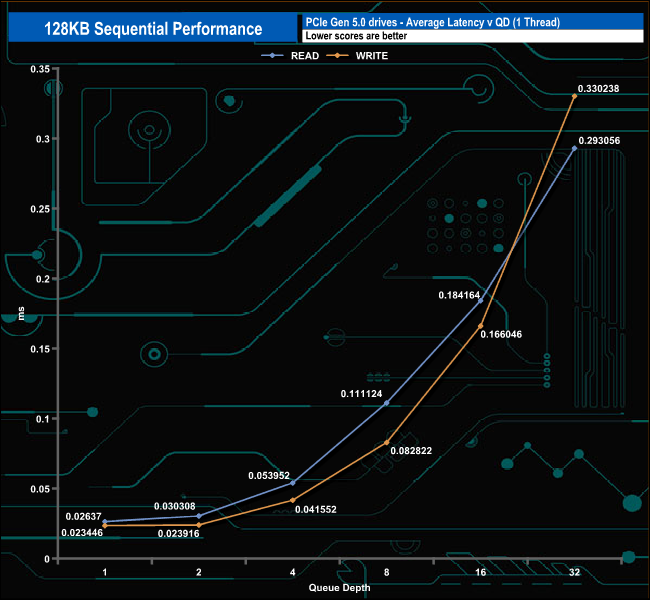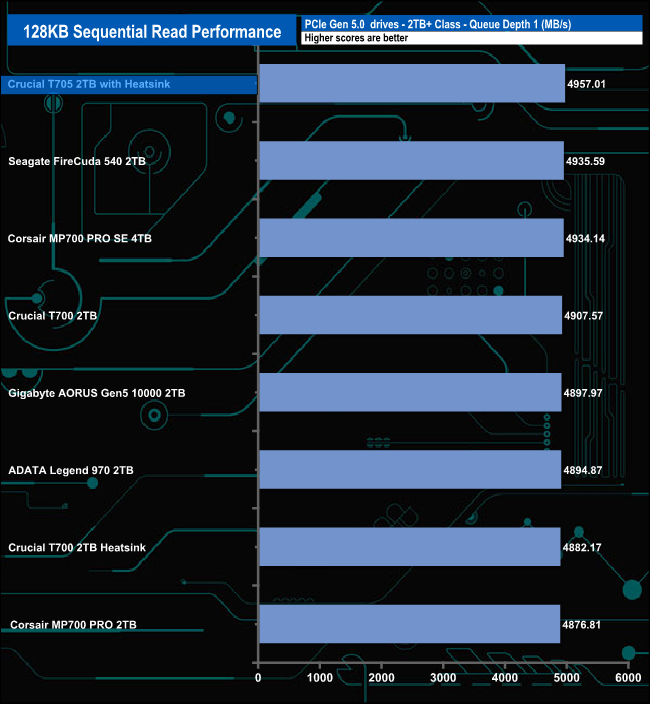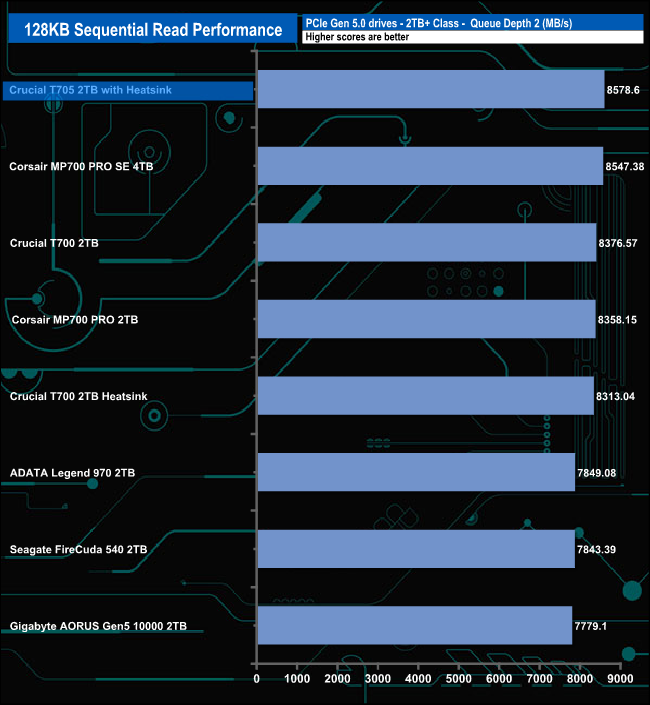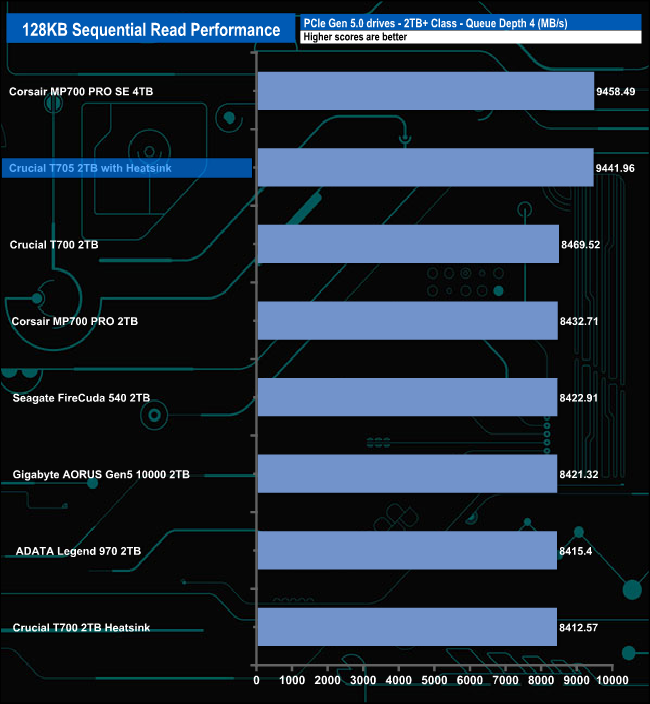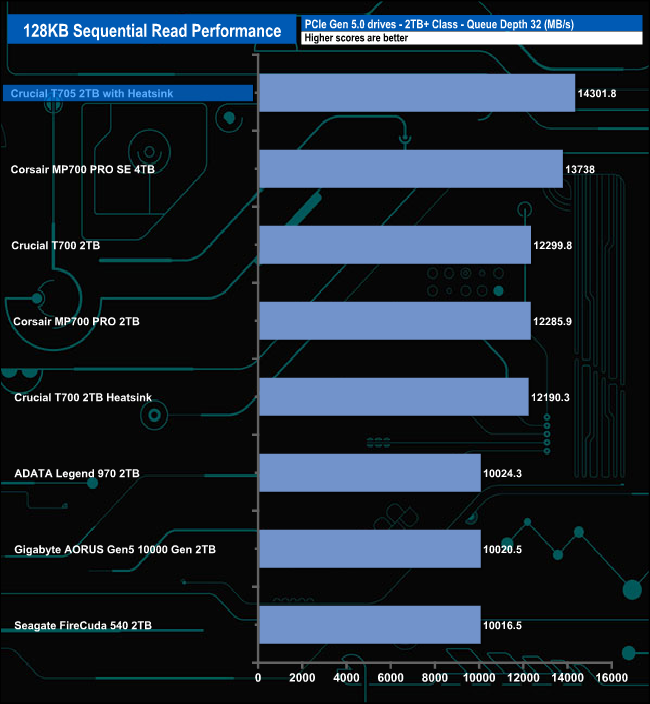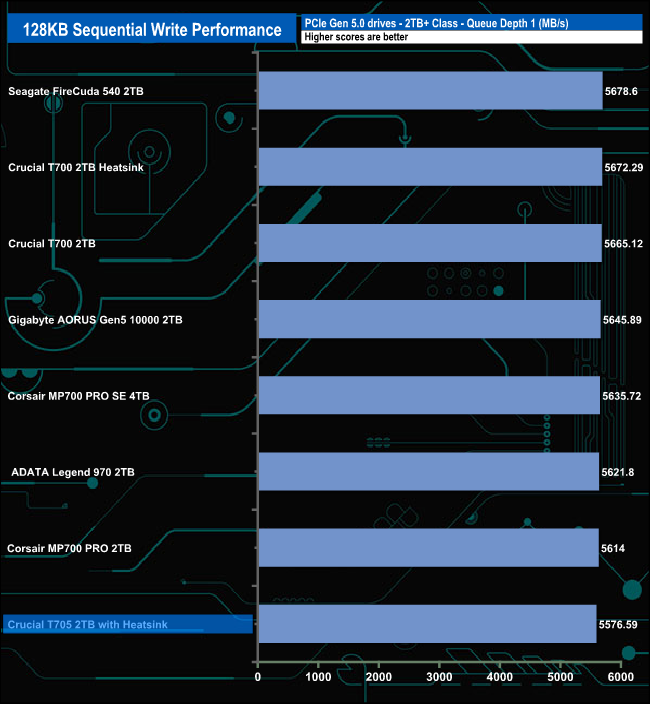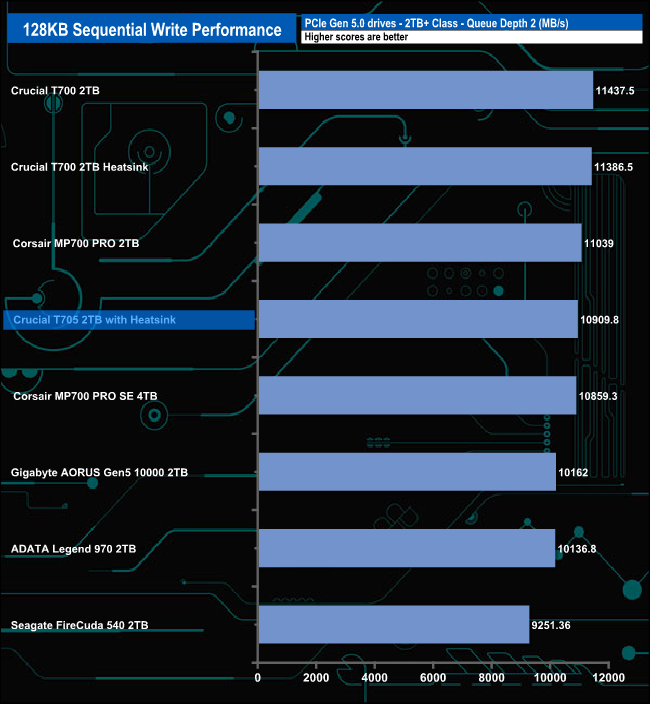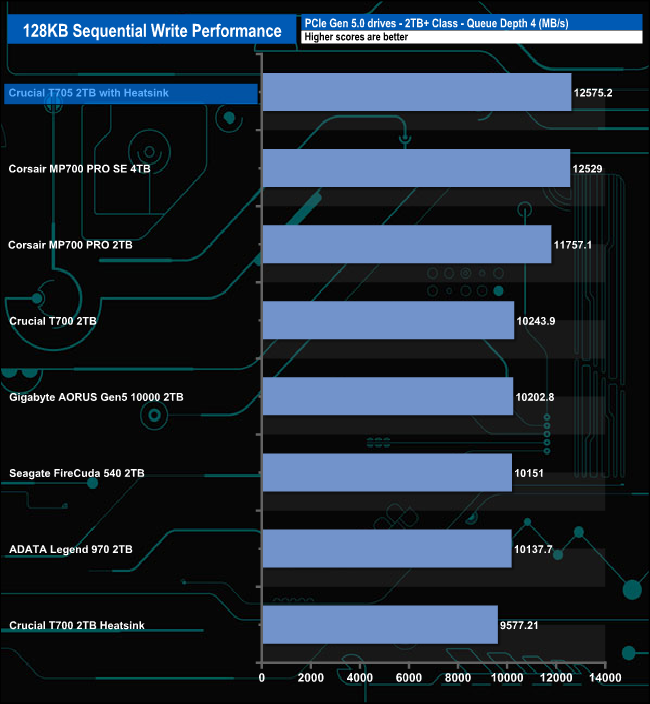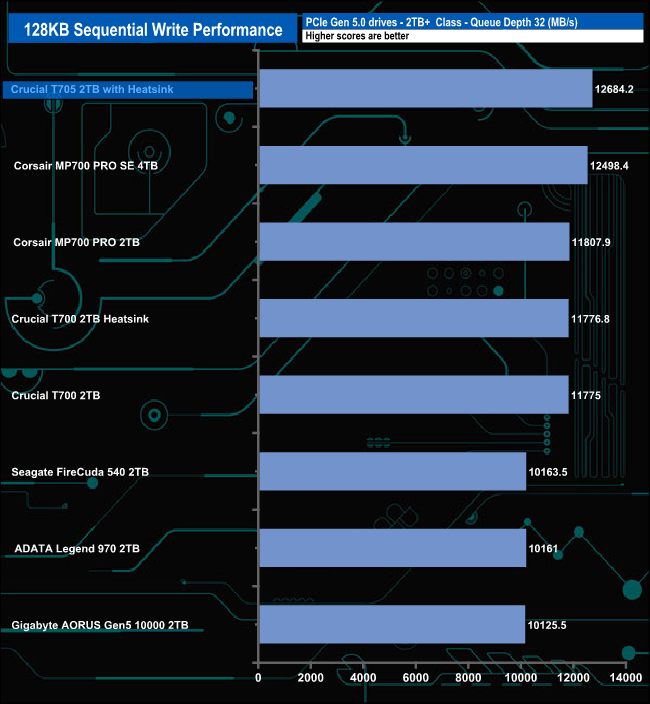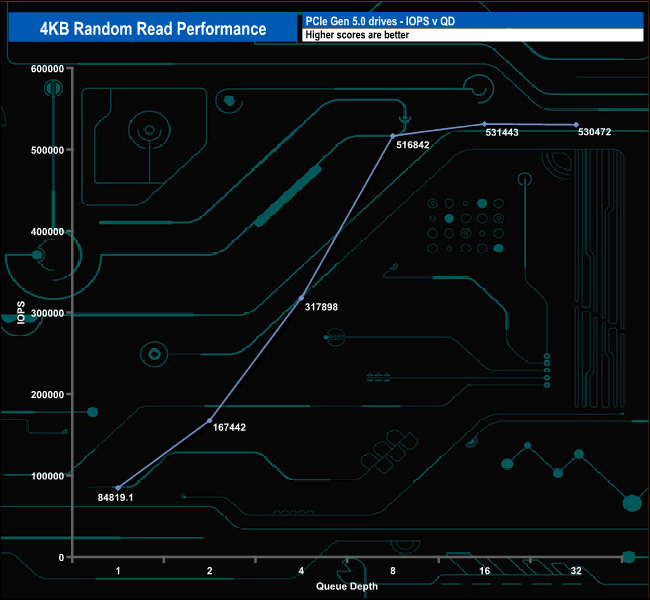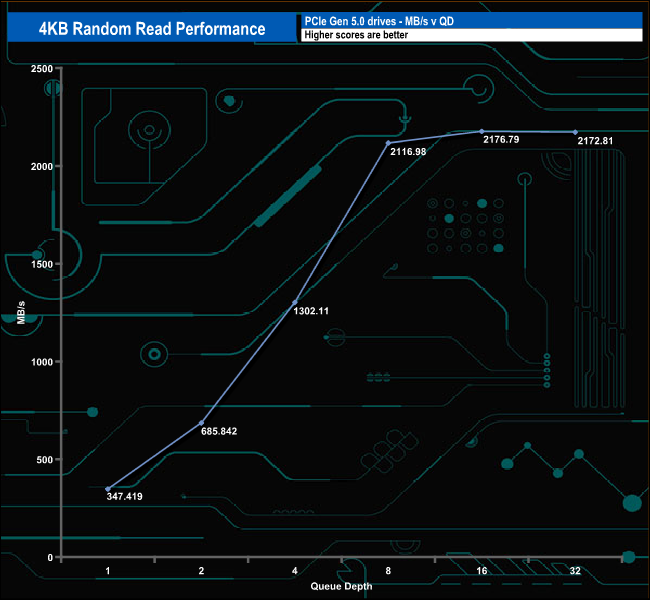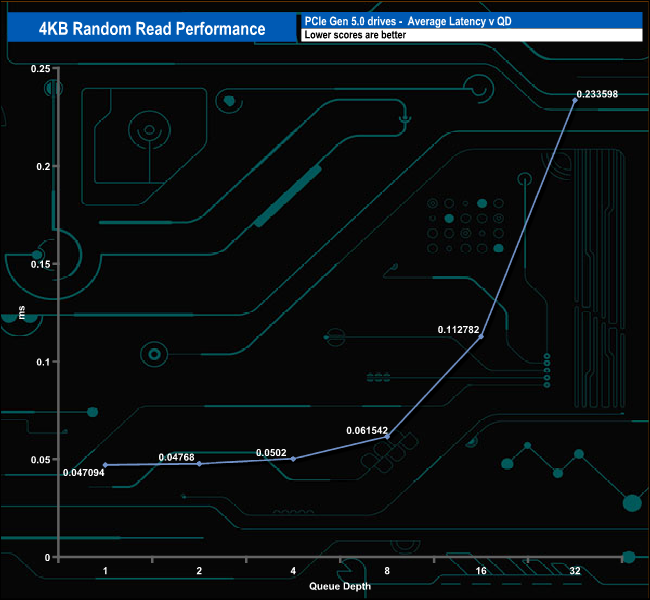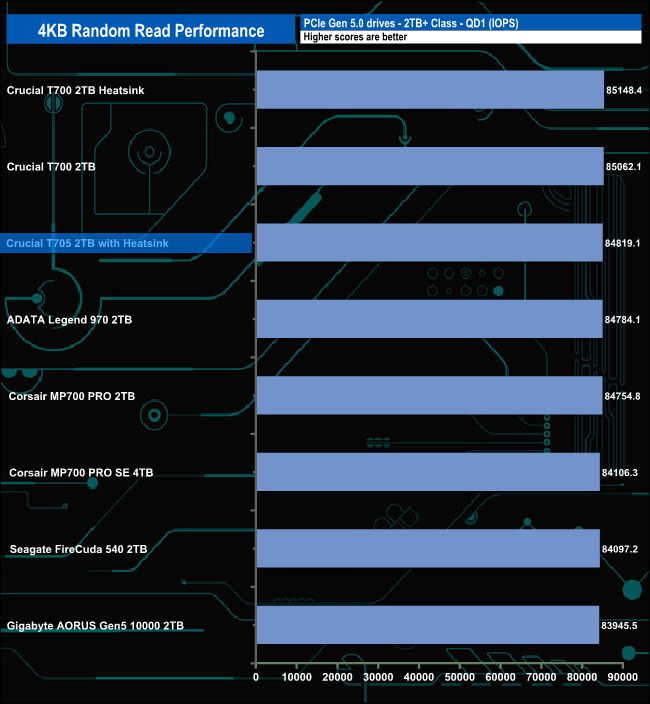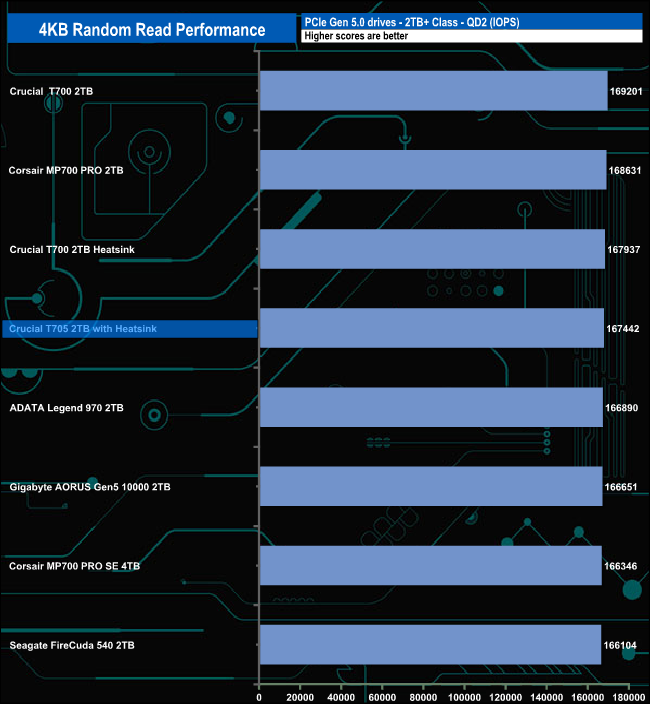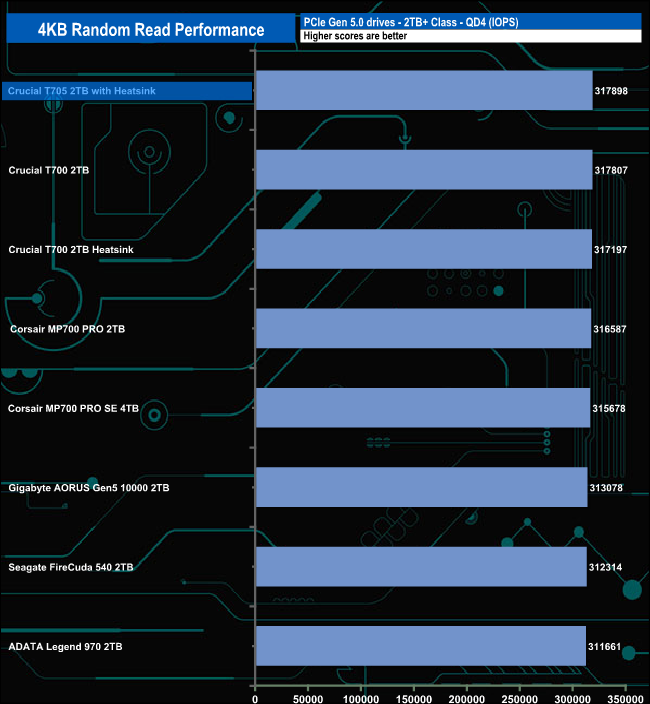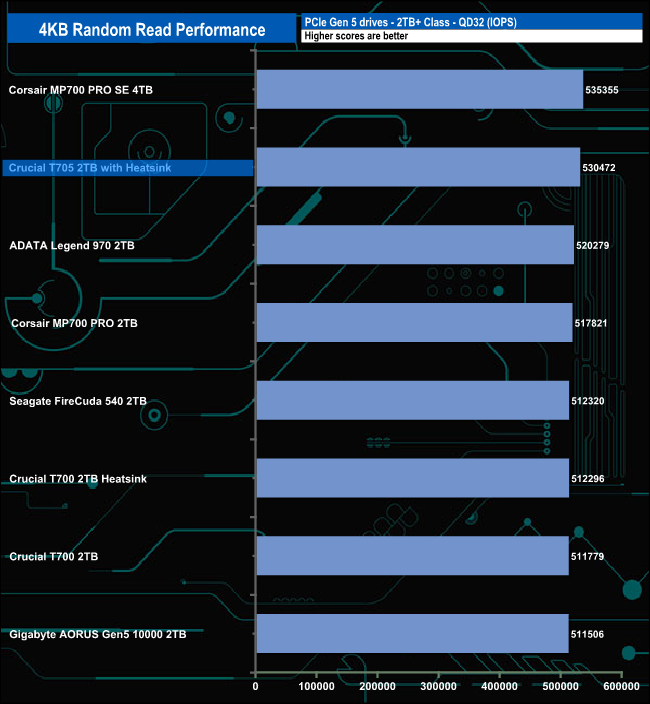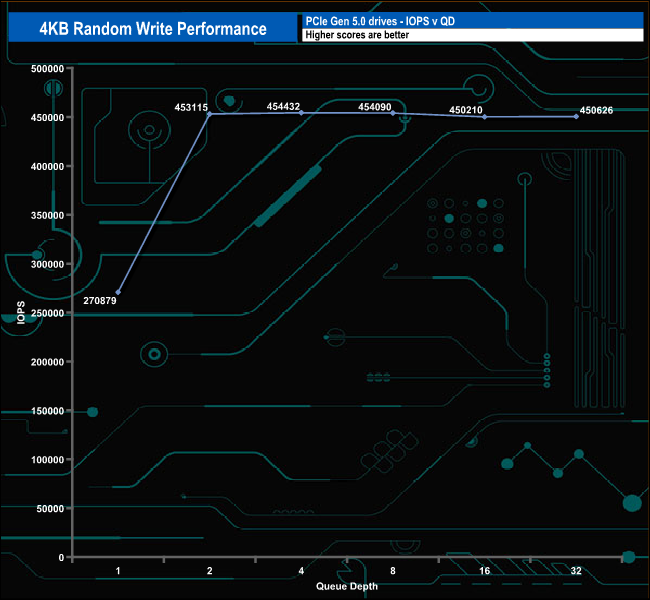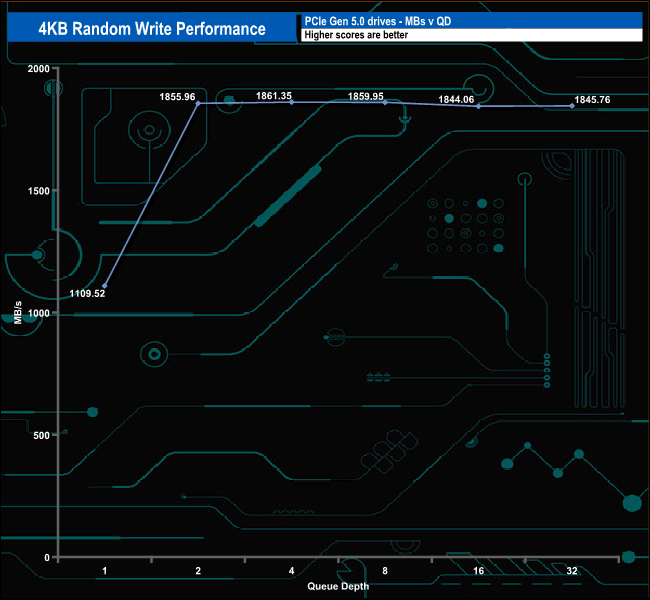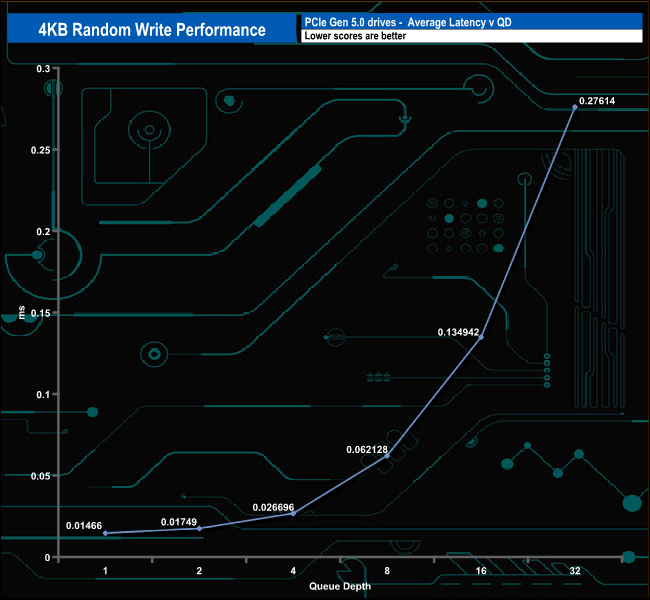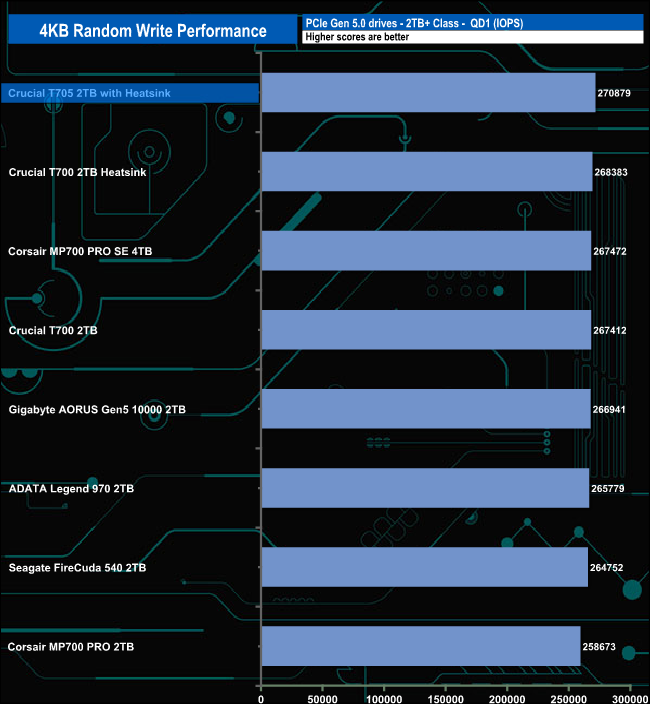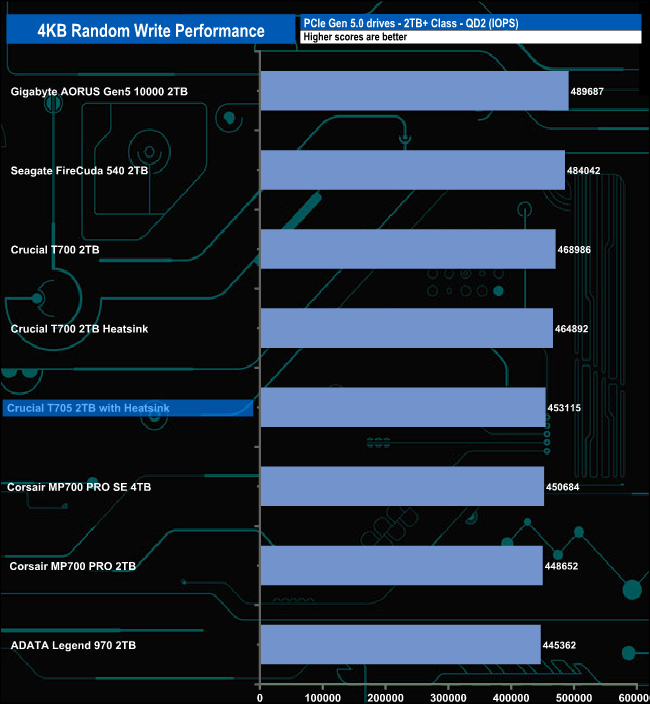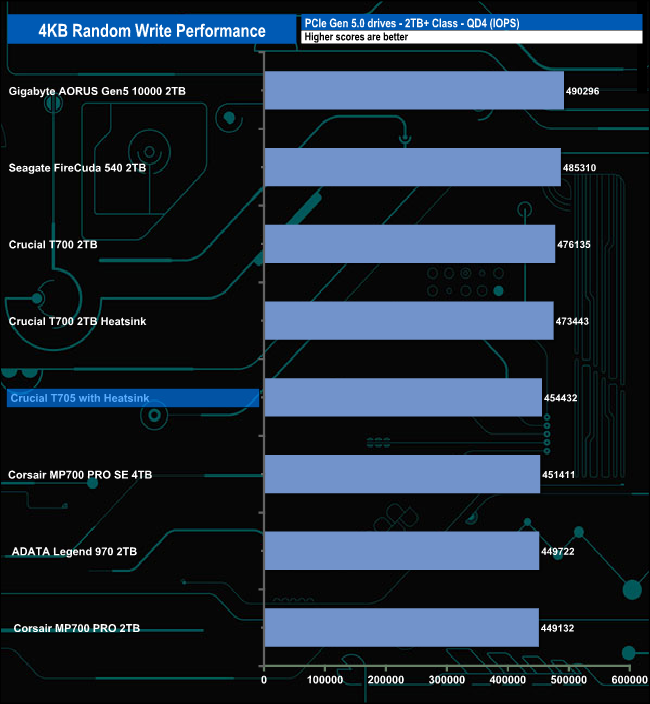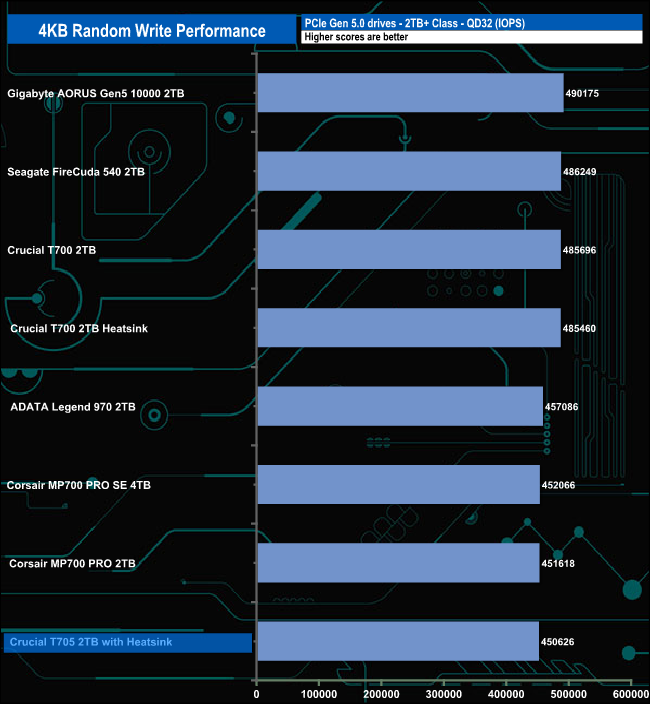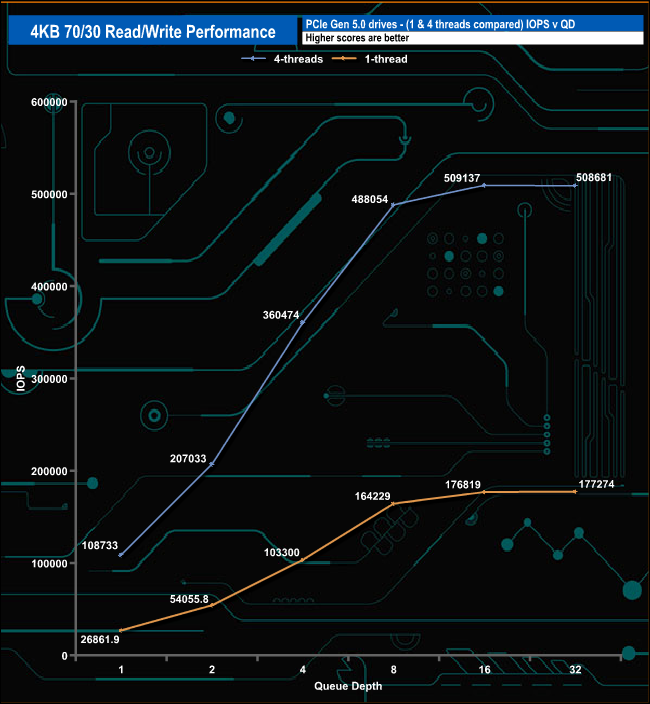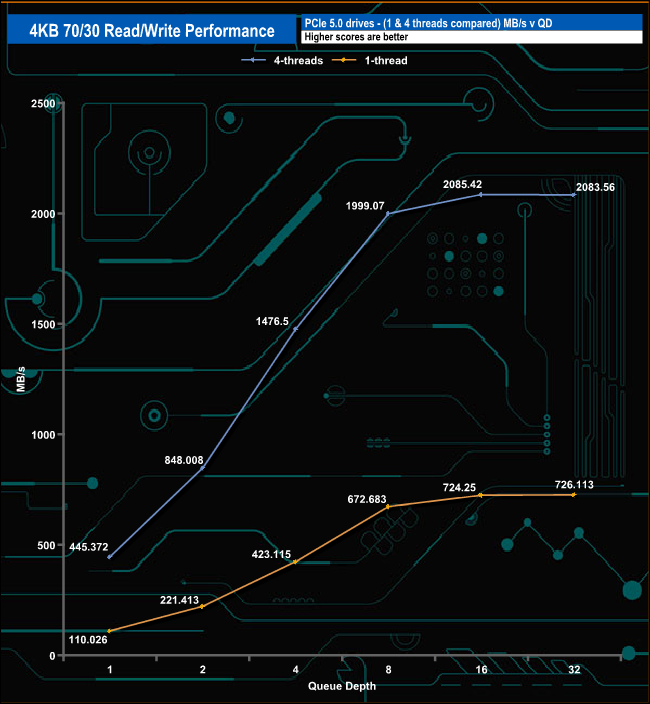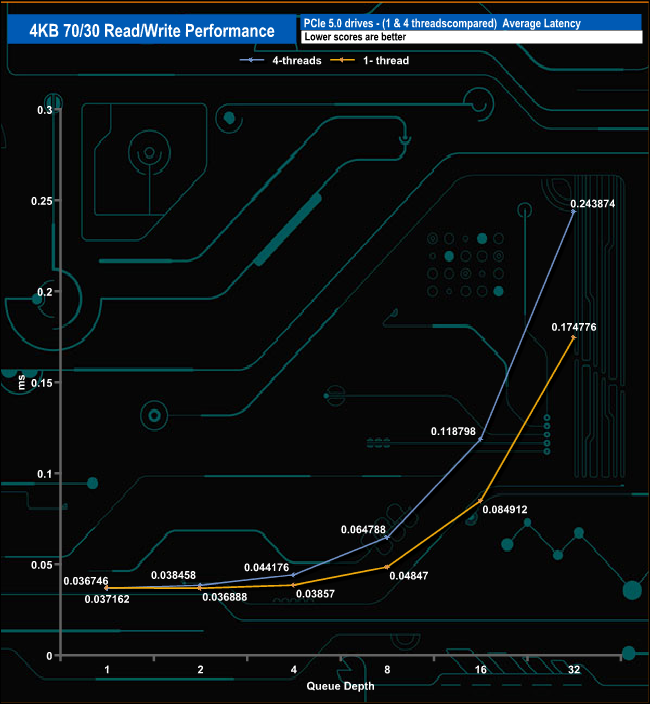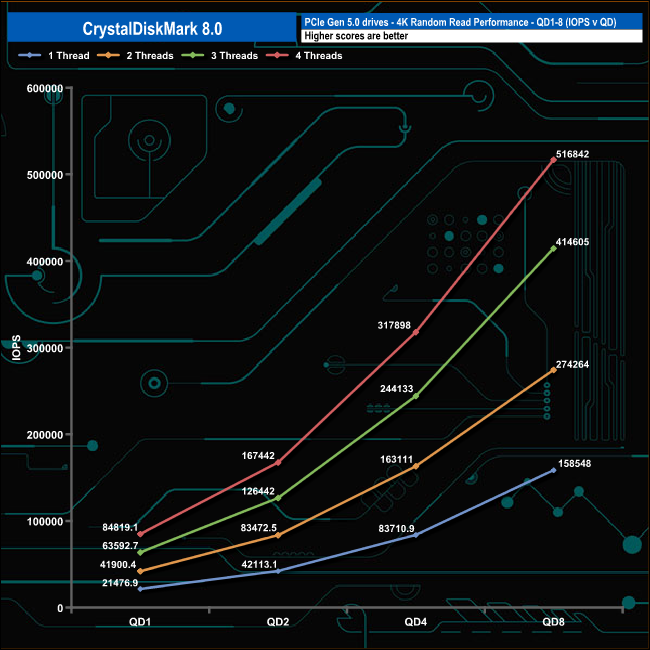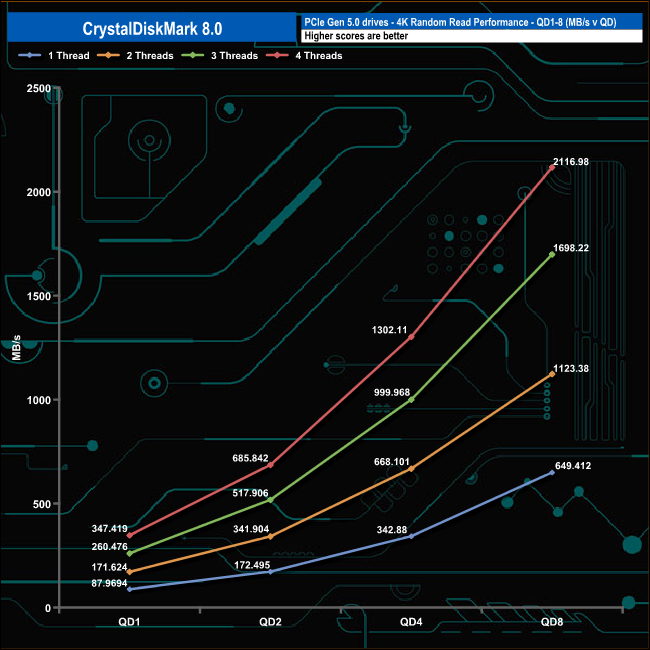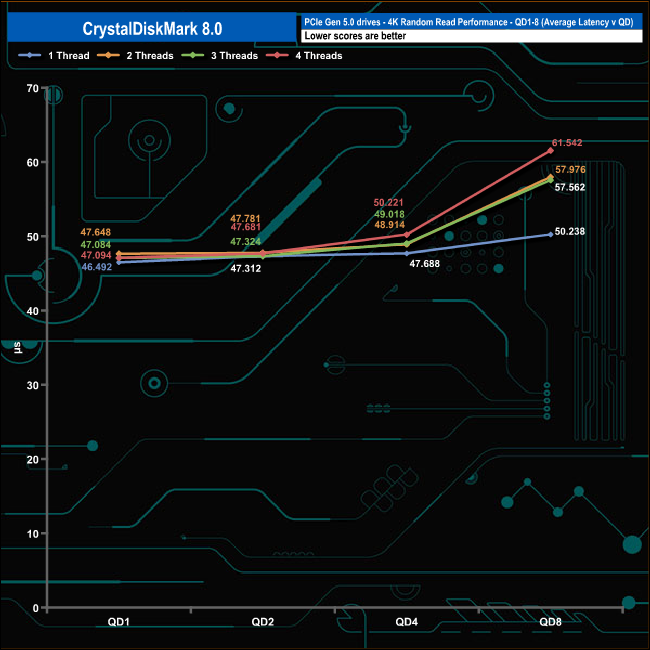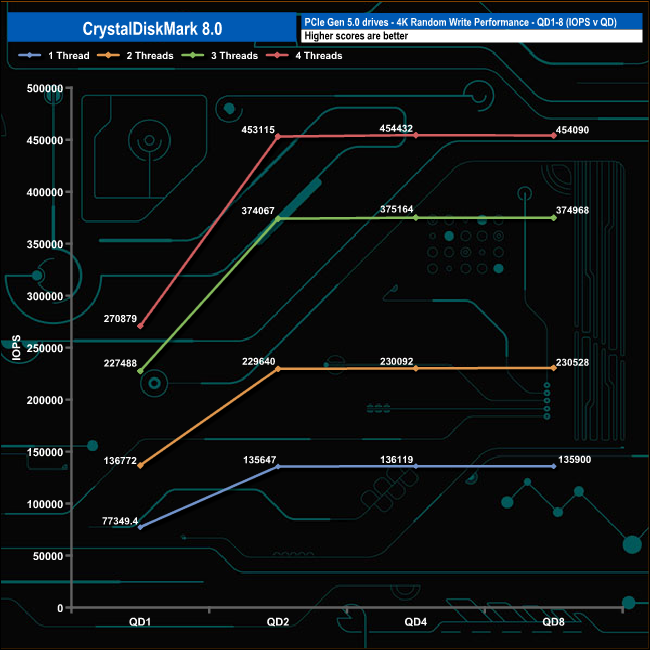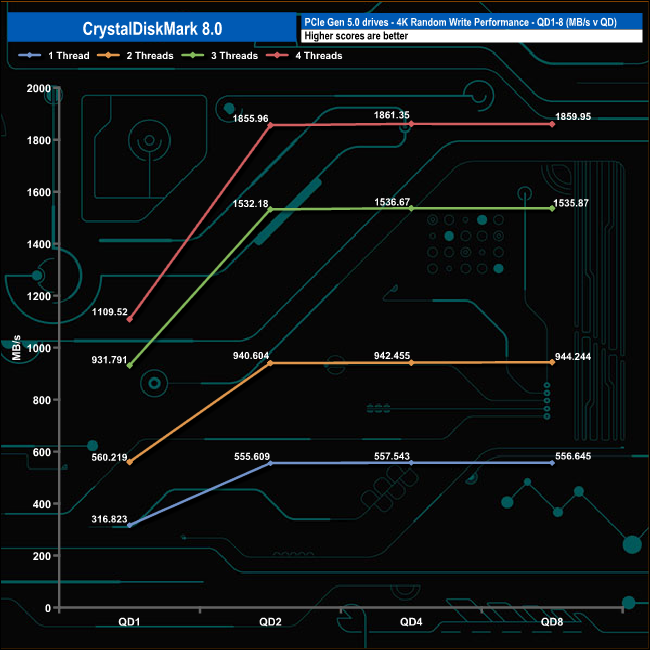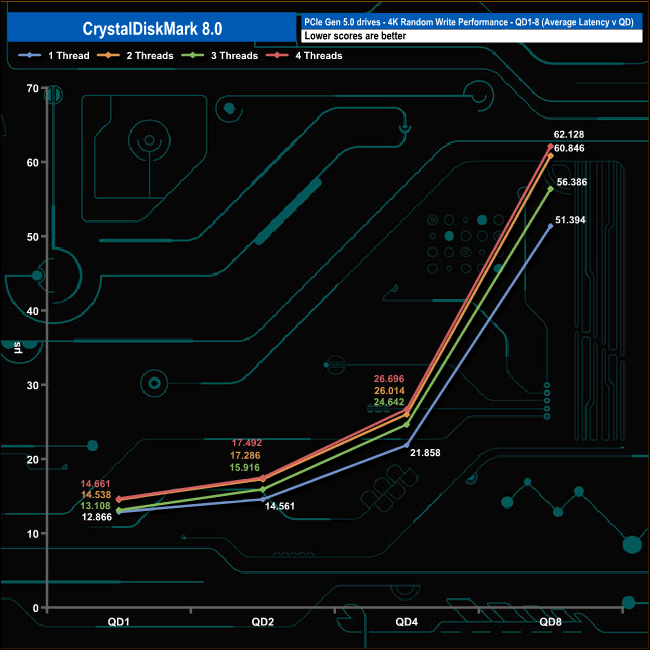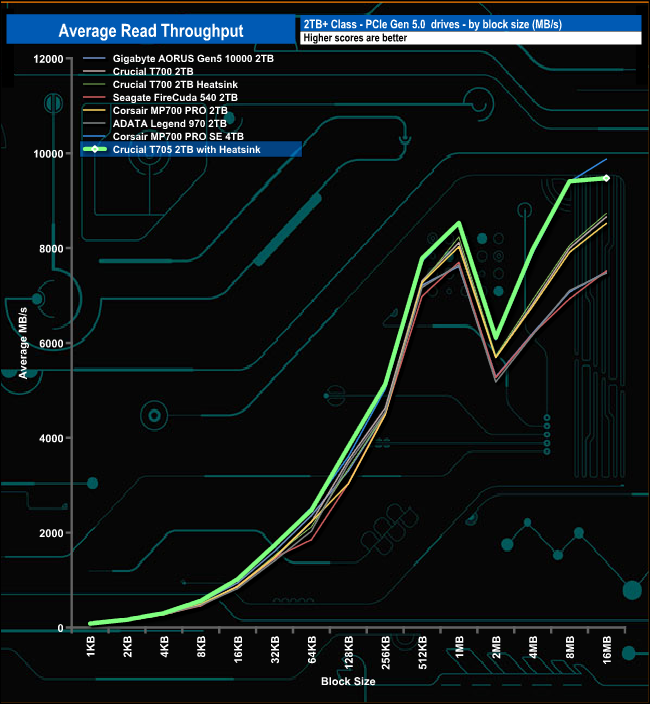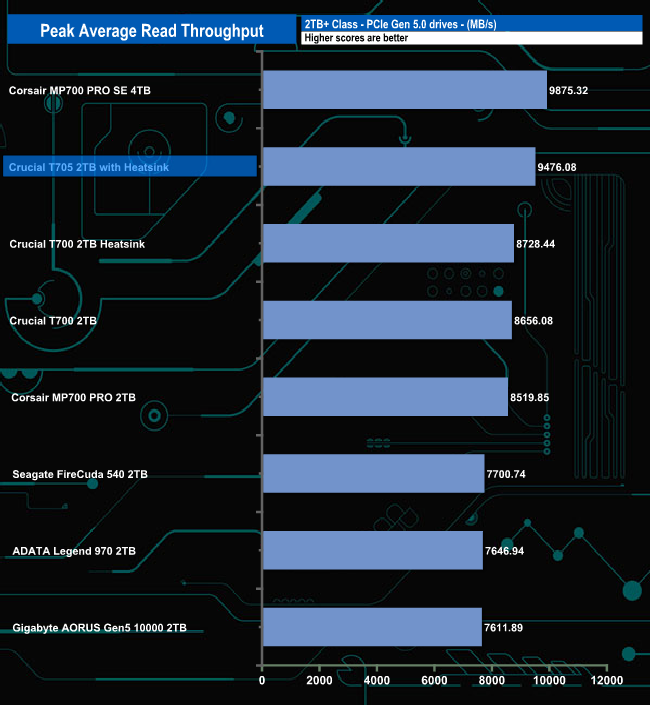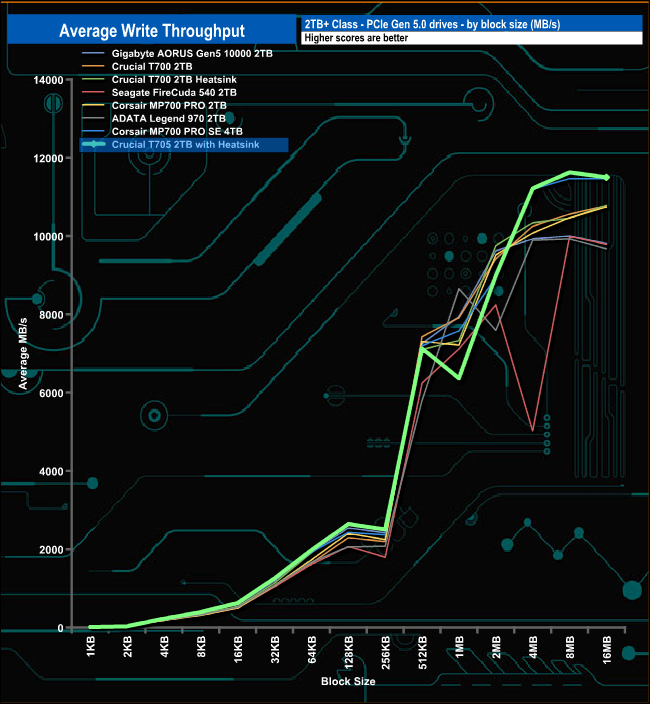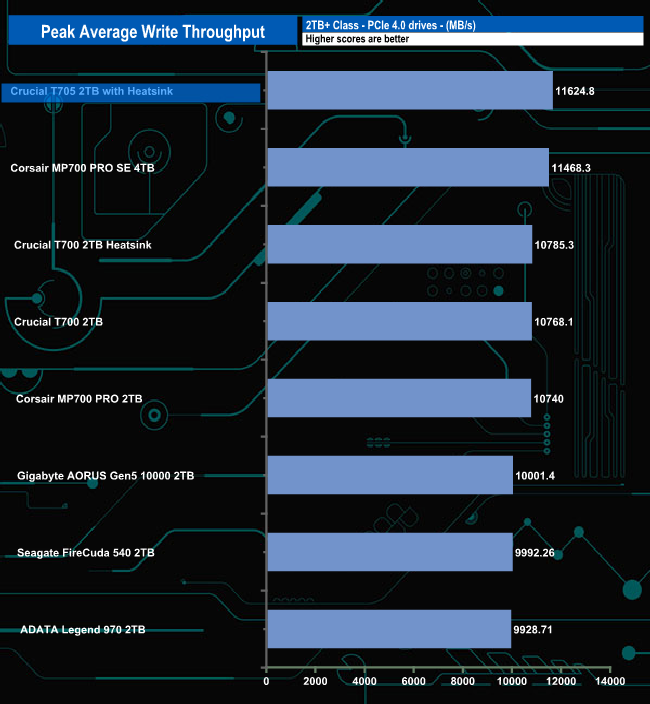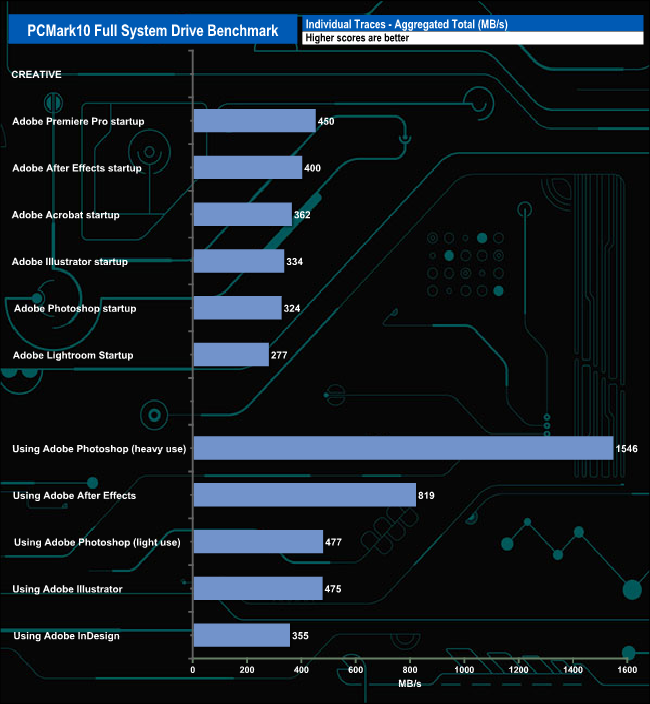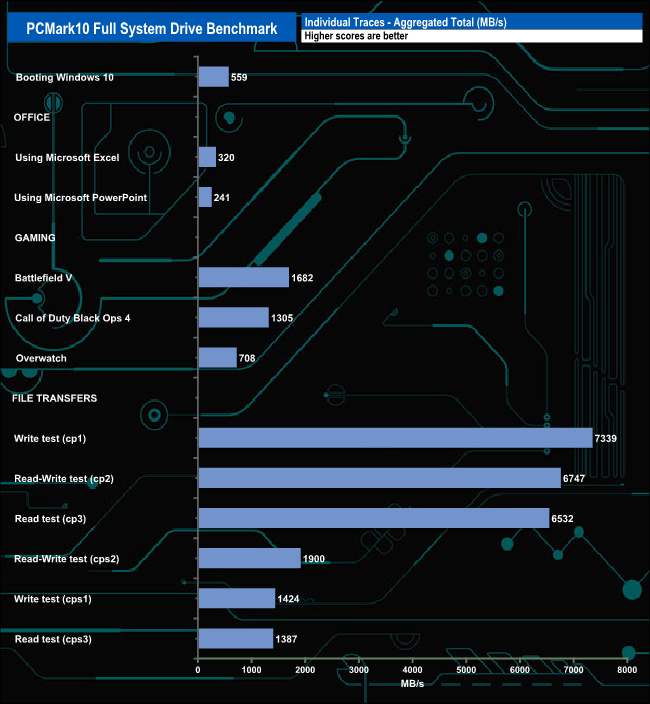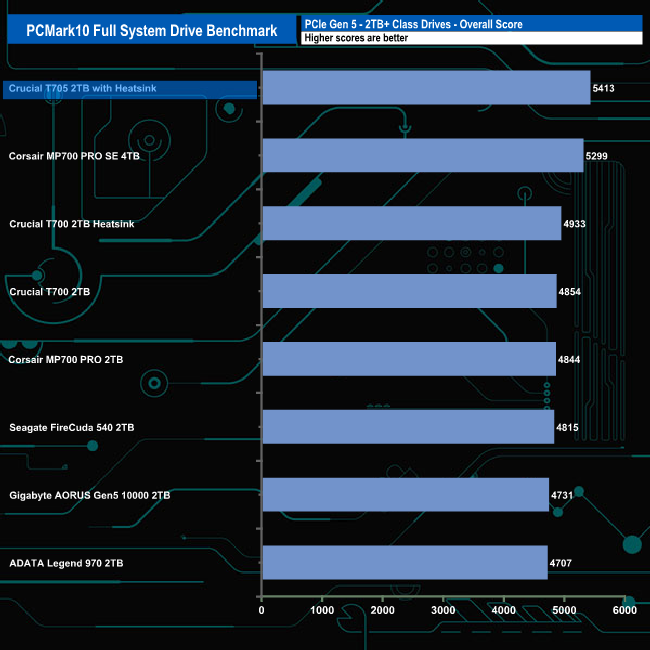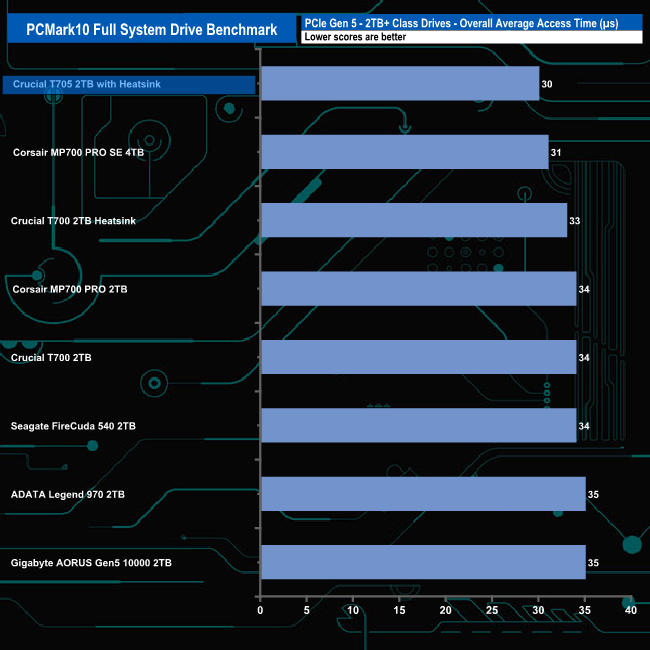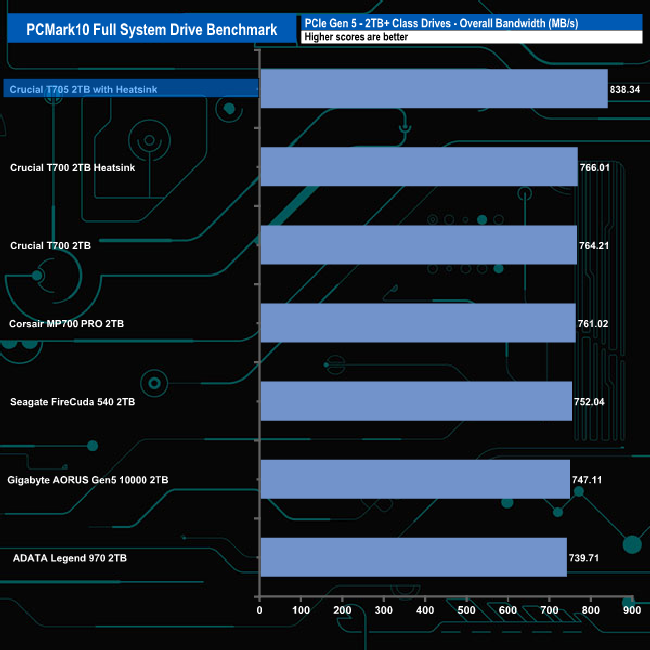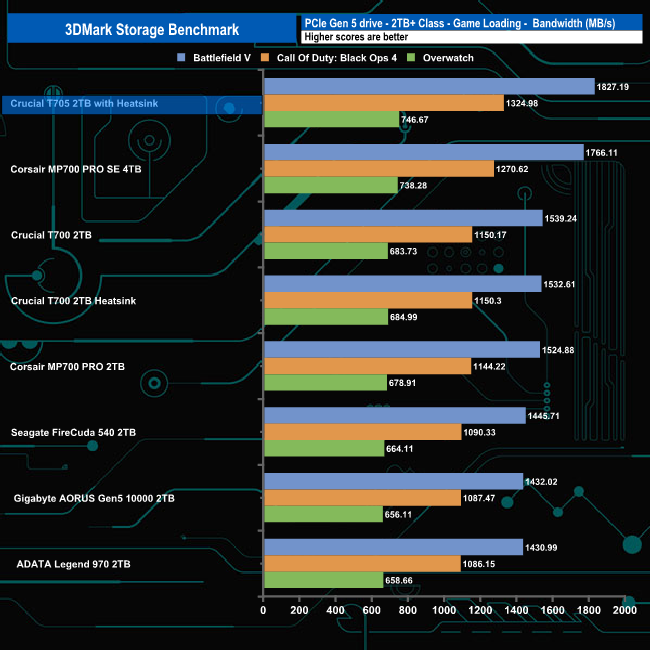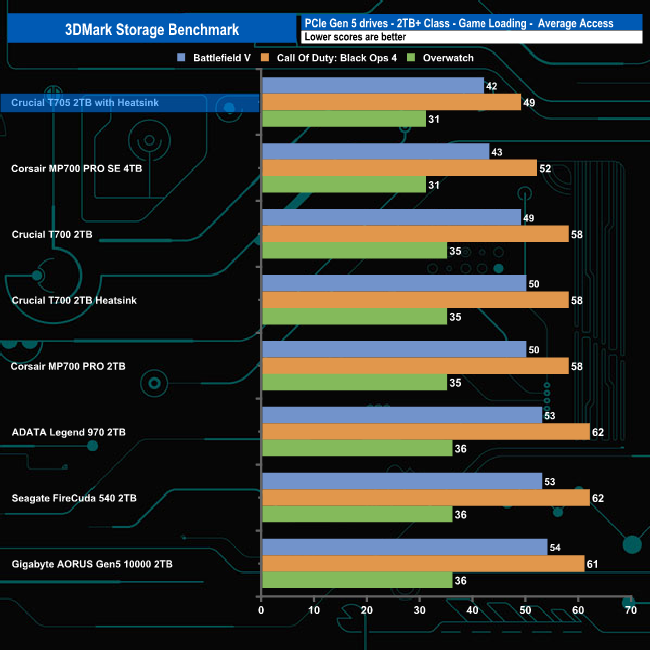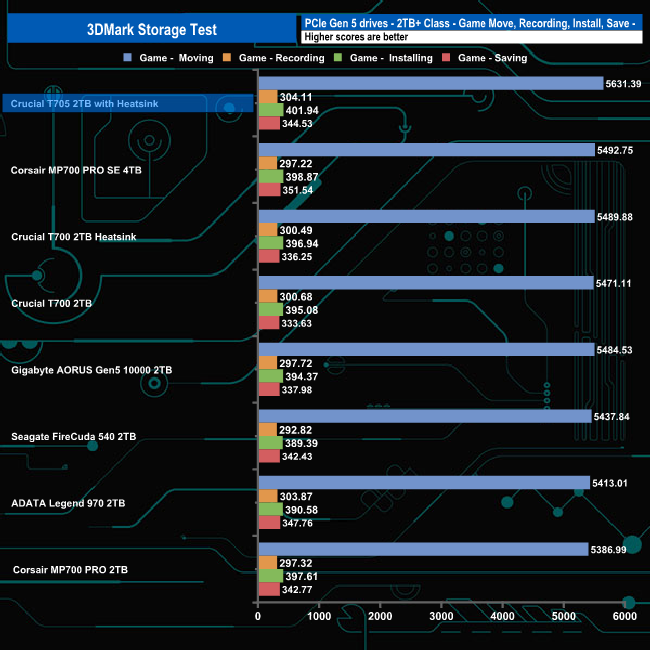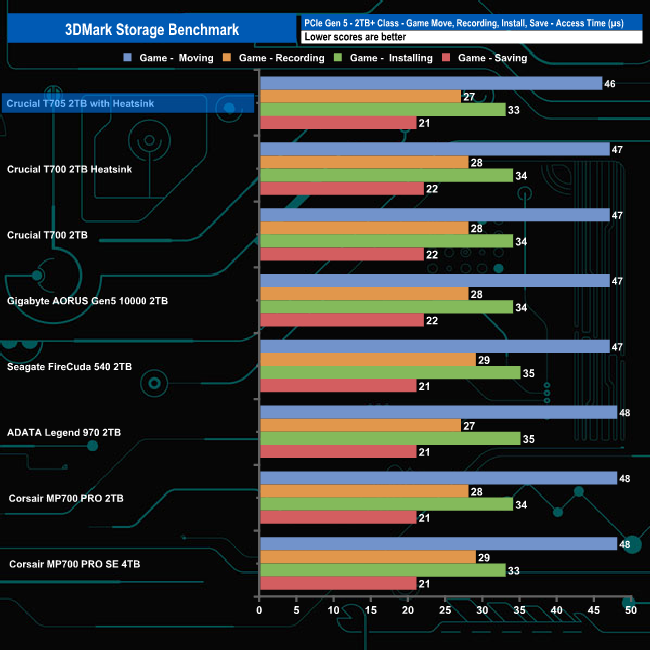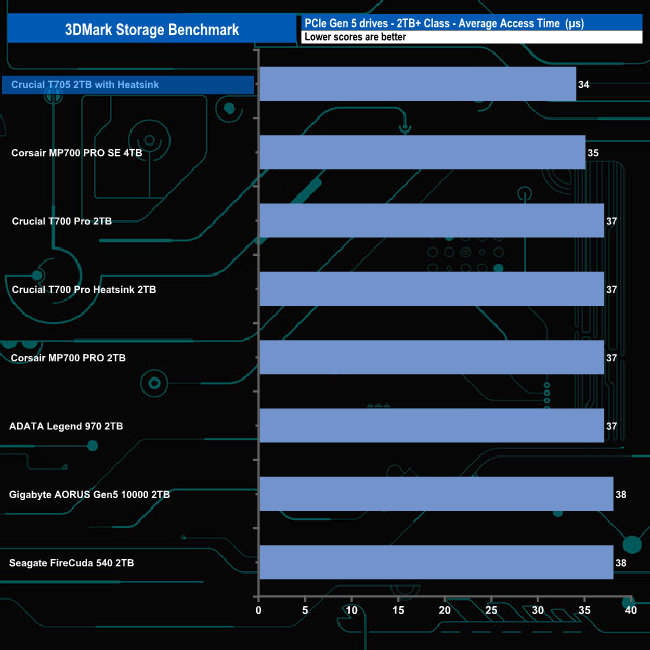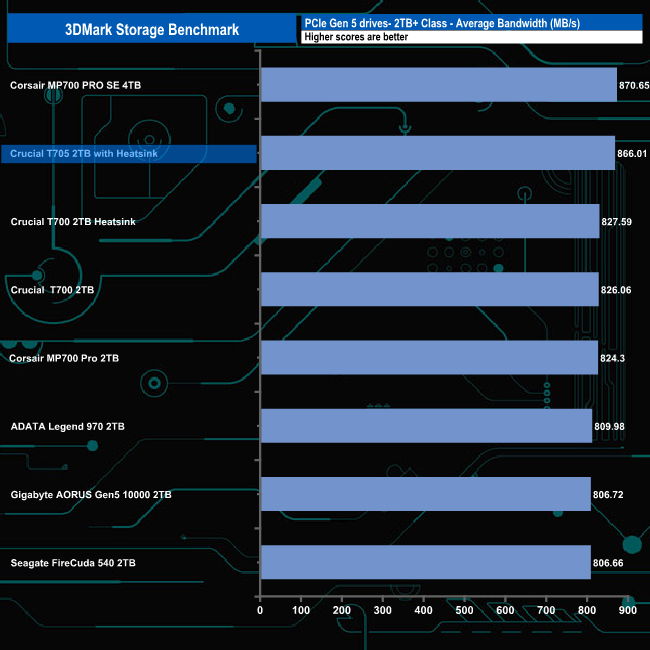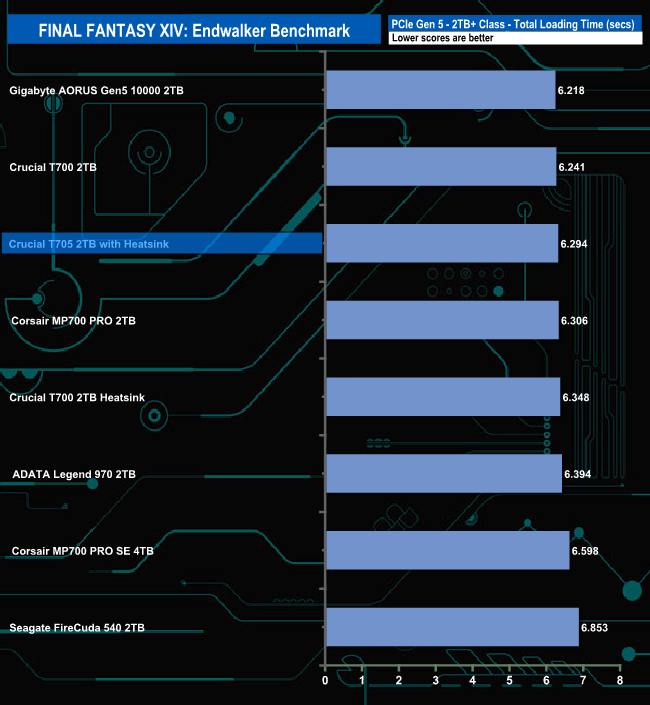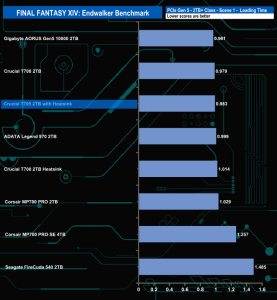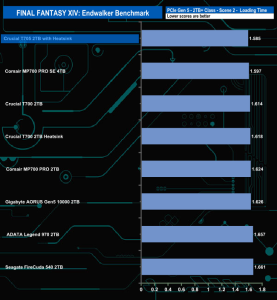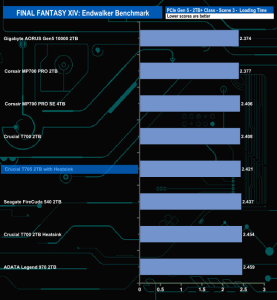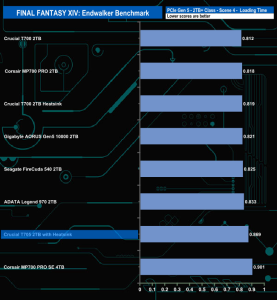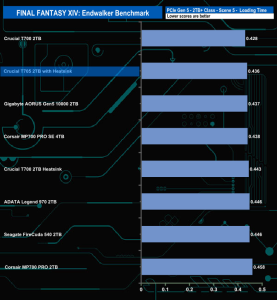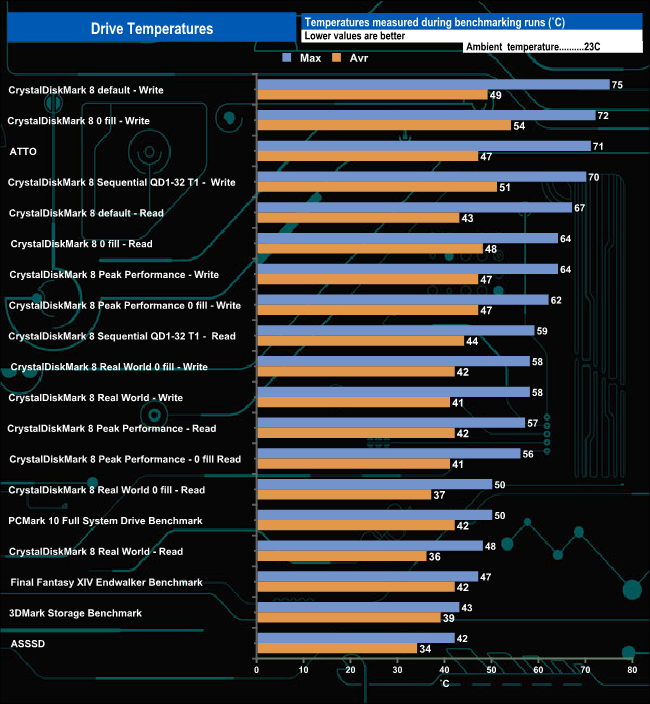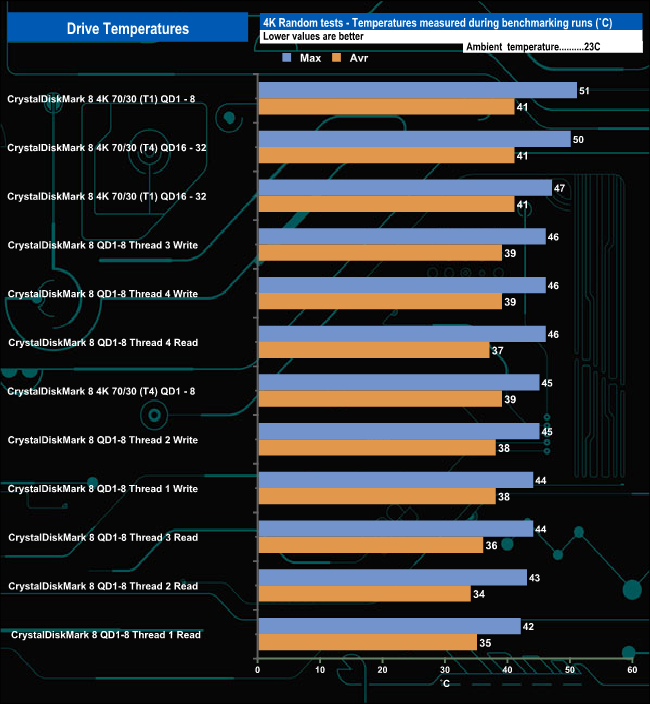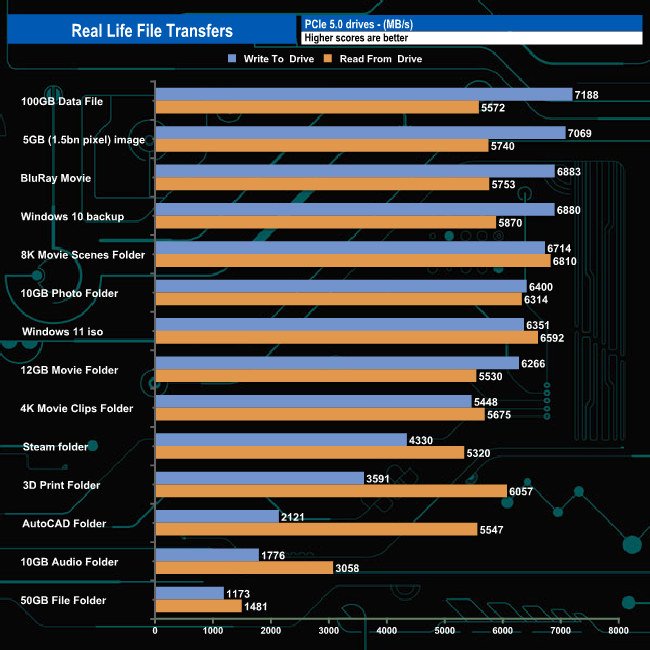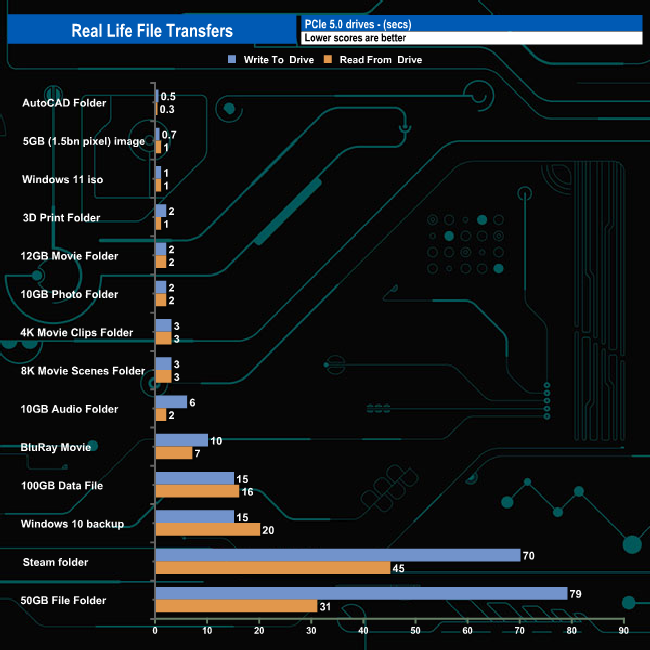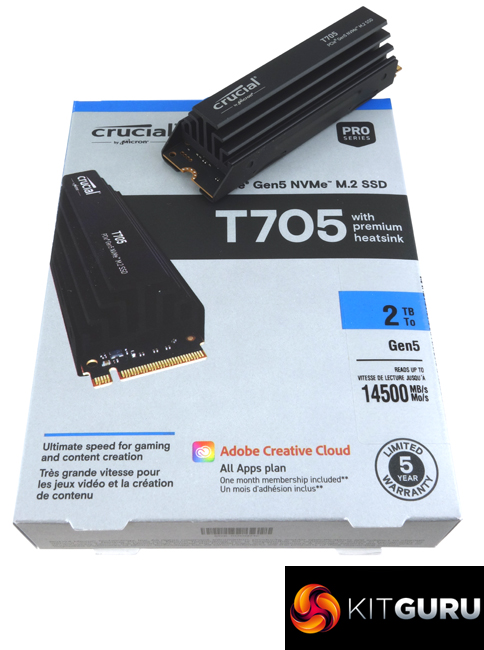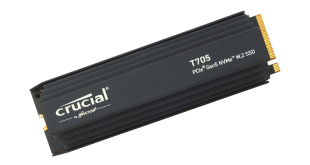
The latest SSD to join Crucial's Pro lineup is the T705, coming in as the new flagship drive of the Pro SSD line. Using a combination of a Phison controller and 232-layer NAND, it's also Crucial's fastest SSD to date. Hitting the market at around £500 for the 2TB model, we find out exactly what sort of speeds this drive can bring to the table…
At launch the T705 is available in three capacities; 1TB, 2TB and 4TB, and two versions, standard or with a factory-fitted heatsink. A limited edition version fitted with a white heatsink is also available, but only at 2TB. Crucial kindly sent us one of the 2TB standard heatsink models for review.
At the heart of the T705 is a Phison PS5026-E26 8-channel controller which looks after Micron 232-Layer 3D TLC NAND. There's also an LPDDR4 DRAM cache chip, the size of which is based on drive capacity at the ratio of 1GB per 1TB.
Crucial quote Sequential read/write speeds for the range as up to 13,600MB/s and 10,200MB/s respectively for the 1TB drive, up to 14,500MB/s and 12,700MB/s for the 2TB model and up to 14,100MB/s and 12,600MB/s for the flagship 4TB drive.
When it comes to 4K performance the 2TB and 4TB drives are rated as up to 1,550,000 IOPS for reads and up to 1,800,000 IOPS for writes. The 1TB drive is rated as up to 1.400,00 IOPS and up to 1,750,000 IOPS for reads and writes respectively.
Crucial quote an endurance figure for the 2TB model of 1,200TBW with figures of 600TBW for the 1TB drive and 2,400TBW for the flagship 4TB model. The range is backed by a five-year warranty.
Physical Specifications:
- Usable Capacities: 2TB.
- NAND Components: Micron 232-Layer 3D TLC.
- NAND Controller: Phison PS5026-E26.
- Cache: 2GB LDDR4.
- Interface: PCIe Gen 5 x4, NVMe 2.0.
- Form Factor: M.2 2280.
- Dimensions: 80 x 22 x 21mm.
- Drive Weight: 48 g.
Firmware Version: PACR5111.
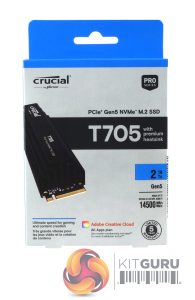
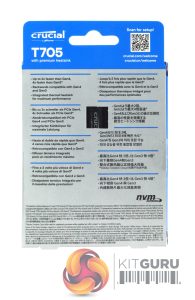
The T705 Heatsink comes in a decent quality box with a good clear image of the drive on the front. To the right of this image is a longish sticker that displays the capacity of the drive, the interface, maximum Sequential read speed and a logo stating the 5-year warranty. There's also mention of the one-month complimentary Adobe Creative Cloud personal All Apps plan (while supplies last). The rear of the box is home to some multi-lingual notes about the drive's speed, backward compatibility and the fact that it has a factory-fitted heatsink.
Under the two-part heat sink, the 2TB T705 is built on a dual-sided M.2 2280 format. Crucial's design for the passive heatsink for the T705 isn't as massive as some we've seen, only adding around 19mm to the height and 39g to the weight of the drive. It's the same heatsink as the T700 uses, constructed from aluminium and nickel-plated copper but unlike the one used in the T700, it doesn't use screws to hold the heatsink and cradle together but instead seems to rely on the thermal paste being used which going by the way that its really difficult to separate the heatsink components must have some sort of superglue mixed in with it. It's so well bonded that we gave up trying to prise the heatsink off in case it caused damage to the PCB.
One side of the PCB holds the Phison PS5026-E26 8-channel controller, two Micron 232-layer (B58R) 3D TLC NAND packages and a 2GB LPDDR4 DRAM IC. The two remaining NAND packages are to be found on the other side of the PCB.
Phison's PS5026-E26 is built on a 12nm process, it uses dual Arm Cortex-R5 cores that work together with Phison’s CoXProcessor 2.0 specialised accelerators. It supports up to 32TB of TLC or QLC NAND flash memory with data transfer speeds of up to 2,400MT/s. The previous T700 drive had the controller and memory running at 2,000MT/s but for the T705 both controller and memory are running at full whack. The controller supports the company's 5th Generation LDPC ECC engine and also provides TCG OPAL 2.0 support which Crucial has enabled on the T705.
Crucial’s Storage Executive is a pretty comprehensive SSD toolkit. With it, you can check the drive’s S.M.A.R.T data, update the firmware, see how the drive’s capacity is being used, monitor the drive’s operating temperature and overall health as well as adjust the Over Provisioning. There are a few more options as well that aren't supported by this particular drive.
For testing, the drives are all wiped and reset to factory settings by HDDerase V4. We try to use free or easily available programs and some real world testing so you can compare our findings against your own system.
This is a good way to measure potential upgrade benefits.
Main system:
AMD Ryzen 7 7700X, 32GB DDR5-6000, Nvidia GeForce RTX 3050 and a Gigabyte AORUS X670E Xtreme motherboard.
Other drives
ADATA Legend 970 2TB
Corsair MP700 PRO SE 4TB
Corsair MP700 PRO 2TB
Crucial T700 2TB
Crucial T700 with Heatsink 2TB
Gigabyte AORUS 10000 2TB
Seagate FireCuda 520 2TB
Software:
Atto Disk Benchmark 4.
CrystalMark 8.0.5.
AS SSD 2.0.
IOMeter.
UL Solutions PC Mark 10.
UL Solutions 3DMark Storage Benchmark.
Final Fantasy XIV Endwalker Official Benchmark.
All our results were achieved by running each test five times with every configuration this ensures that any glitches are removed from the results. Trim is confirmed as running by typing fsutil behavior query disabledeletenotify into the command line. A response of disabledeletenotify =0 confirms TRIM is active.
CrystalDiskMark is a useful benchmark to measure the theoretical performance levels of hard drives and SSDs. We are using v8.0.5.
In CrystalDiskMark 8's 4K QD1 T1 test, the Crucial T705 with Heatsink takes over the top spot from the T700 heatsink version but only just, but enough to be the fastest drive we've seen to date in this test.
As you can see from the benchmark default result screen we can confirm the official Sequential read/write figures of 14,500MB/s and 12,700MB/s respectively with test result figures of 14,506.47MB/s for reads and 12,739.40MB/s for writes.
Those Sequential scores are the fastest we've seen to date for a consumer NVMe SSD. The T705 is some 2,101MB/s faster than the previous T700 for reads and 913MB/s faster when it comes to writes.
Peak Performance Profile.
Looking at the Peak Performance benchmark result screens we could confirm the official 4K random read figure of 1,550,000 IOPS with a default test result of 1,575,736 IOPS. When it comes to random writes, the test result of 1,654,925 IOPS was somewhat off the official maximum of 1,800,000 IOPS.
Using the Peak Performance profile of the CrystalDiskMark benchmark we could once again confirm the official Sequential performance figures.
Once again those Peak Performance profile Sequential figures are strong enough to put the drive in the top spot on the results chart.
Real World Profile.
In the Real World Profile Sequential test, the T705 sits just behind the T700 when it comes to reads but the T705 has a much stronger write performance, 10,925MB/s compared to 10,008MB/s.
The ATTO Disk Benchmark performance measurement tool is compatible with Microsoft Windows. Measure your storage system performance with various transfer sizes and test lengths for reads and writes. Several options are available to customize your performance measurement including queue depth, overlapped I/O and even a comparison mode with the option to run continuously.Use ATTO Disk Benchmark to test any manufacturer's RAID controllers, storage controllers, host adapters, hard drives and SSD drives and notice that ATTO products will consistently provide the highest level of performance to your storage. ATTO uses RAW or compressible data.
We are using version 4.1 for our NVMe disk tests with a set length of 256 MB and test both the read and write performance.
Using the ATTO benchmark we couldn't quite get to the official maximum Sequential figures of up to 14,500MB/s (reads) and 12,700MB/s (writes). However, the read-and-write results we did get, 12,970MB/s and 11,800MB/s put the drive into the top spot on the results graph.
Using the ATTO benchmark, the read performance begins to plateau out at I/O size of 128KB (8,780MB/s) but it recovers at 512KB to peak at the 4MB mark at 13,590MB/s before dropping back slightly to finish the test run at 13,530MB/s. The write performance peaks at the 128KB mark at 11,780MB/s and more or less stays there until the end of the test.
AS SSD is a great free tool designed just for benching Solid State Drives. It performs an array of sequential read-and-write tests, as well as random read and write tests with sequential access times over a portion of the drive. It uses
incompressible data samples which many drives struggle with, so results can be viewed as the worst case scenarios.
AS SSD includes a sub suite of benchmarks with various file pattern algorithms but this is difficult in trying to judge accurate performance figures.
The AS SSD read score of 4936 sees the Crucial T705 with Heatsink in second place just above the T700 drive. That read figure may be the second fastest we've seen to date but the write score of 6996 is the fastest write score we've seen.
We used CrystalDiskMark 8‘s custom settings to test the Sequential read and write performance of the drive through a range of queue depths. The setup for the tests is listed below.
128KB Sequential Read / Write.
Transfer Request Size: 128KB, Thread(s): 1, Outstanding I/O: 1-32.
In this test, the read performance of the drive accelerates between QDs 1 and 4 before levelling off between QD4 and 8 before climbing again to finish the test run at 14,301MB/s. The write performance races away but the performance starts to plateau out at QD4 (12,575.2MB/s), finishing the test run at 12,684.2MB/s.
128KB Sequential Read Performance compared.
The 2TB Crucial T705 with Heatsink is the fastest drive we've seen in this test at all the tested queue depths except for QD4, where it sits in second place, just behind Corsair's MP700 PRO SE.
128KB Sequential Write Performance compared.
At QD 1 the drive sits at the bottom of the results chart, by QD2 it sits in a mid position in the results chart. At QDs 4 and 32, it's the fastest drive we've seen in this test to date.
We used CrystalDiskMark 8‘s custom settings to test the 4K random read performance of the drive through a range of queue depths. The setup for the tests is listed below.
Transfer Request Size: 4KB, Outstanding I/O: 1-32.
In our four-threaded 4K random read tests we couldn't get close to the official maximum of 1,550K IOPS. The best figure we saw was 531,443 IOPS (2,176.79MB/s) at QD16.
4K Random Read v QD Performance compared.
In relation to the other Gen 5 drives we've tested, the T705 performs best at QD4, sitting on top of the results chart. At QDs 1 and 2 it isn't quite as fast as the previous T700 and at QD32 it sits in second place in the results chart behind the Corsair MP700 PRO SE.
We used CrystalDiskMark 8‘s custom settings to test the 4K random write performance of the drive through a range of queue depths. The setup for the tests is listed below.
Transfer Request Size: 4KB, Outstanding I/O: 1-32.
As with the random read results with our four threaded random write tests, we couldn't get close to the official maximum of 1,800K IOPS. The best we saw from testing was 454,432 IOPS at QD4.
4K Random Write v QD Performance compared.
Even though our test results couldn't get anywhere near the official figure, the drive still ranks as the fastest consumer NVMe drive we've seen to date at QD1. But as the queue depth deepens the performance drops back compared to its competitors until at QD32 it sits in last place in the results chart.
We used CrystalDiskMark 8’s custom settings to test the 4K 70/30 mixed read/write performance of the drive through a range of queue depths using a single thread and four threads.
Using a single thread, the Crucial T705 with Heatsink performance climbs in a fairly smooth curve from 26,861 IOPS (110.026MB/s) at QD1 up to 176,819 IOPS (724.25B/s) at QD16 where the performance begins to level off, finishing the test run at 177,274 IOPS (726.11MB/s) at QD32.
Switching to four threads, the performance goes from 108,733 IOPS (445.37MB/s) at QD1 up to 509,137 IOPS (2085.42MB/s) at QD16 where the performance again starts to level off, finishing the test run at QD32 with 508,681 IOPS (2083.56MB/s).
We used CrystalDiskMark 8 to test the random performance of the drive at lower queue depths (QD1 – QD8 where most of the everyday workloads occur) using 1 to 4 threads.
Random Reads
In the random read tests, all four of the tested threads displayed smooth increases in performance as the queue depth deepened. Test results at QD8 ranged from 158,548 IOPS using a single thread up to 516,842 IOPS using four threads.
Random Writes
In the 4K write tests the performance rose quickly from QD1 to QD2 for all four tested threads with the fastest rises seen in the three and four threaded tests. All four threads see the performance levelling off from QD2 onwards.
In our read-throughput tests, the Crucial T705 with Heatsink performance climbed smoothly through the block marks until the 1MB mark where the performance drops off pretty considerably dropping from 8,531MB/s down to 6,111MB/s. However, from the 2MB block mark onwards the drive recovers well to finish the test runs at 9,476.08MB/s, some way off the official maximum of 14,500MB/s.
Even though the peak read result is nowhere near the official maximum figure, it's still good enough to place the drive in second spot on the results chart behind Corsair's MP700 PRO SE drive. The T705 is 748MB/s and 820MB/s faster than the heatsink and standard versions respectively of the previous T700.
In the write-throughput test, the drive starts to plateau out between 128KB and 256KB before accelerating to the 512KB mark where it drops from 7,127MB/s to 6,365MB/s. It recovers quickly to peak at the 8MB block size at 11,624MB/s before dropping back to finish the test run at 11,499MB/s.
The tested peak write result of 11,624MB/s is somewhat short of the official maximum of 12,700MB/s but still good enough to put the drive on the top of the results chart and is faster than both versions of the previous T700 drive.
The PCMark 10 Full System Drive Benchmark uses a wide-ranging set of real-world traces from popular applications and common tasks to fully test the performance of the fastest modern drives. The benchmark is designed to measure performance of fast system drives using the SATA bus at the low end and devices connected via PCI Express at the high end.
The goal of the benchmark is to show meaningful real-world performance differences between fast storage technologies such as SATA, NVMe, and Intel’s Optane. The Full System Drive Benchmark uses 23 traces, running 3 passes with each trace. It typically takes an hour to run.
Traces used:
Booting Windows 10.
Adobe Acrobat – starting the application until usable.
Adobe Illustrator – starting the application until usable Adobe Premiere Pro – starting the application until usable.
Adobe Photoshop – starting the application until usable.
Battlefield V – starting the game until the main menu.
Call of Duty Black Ops 4 – starting the game until the main menu.
Overwatch – starting the game until main menu.
Using Adobe After Effects.
Using Microsoft Excel.
Using Adobe Illustrator.
Using Adobe InDesign.
Using Microsoft PowerPoint.
Using Adobe Photoshop (heavy use).
Using Adobe Photoshop (light use).
cp1 Copying 4 ISO image files, 20 GB in total, from a secondary drive to the target drive (write test).
cp2 Making a copy of the ISO files (read-write test).
cp3 Copying the ISO to a secondary drive (read test).
cps1Copying 339 JPEG files, 2.37 GB in total, to the target drive (write test).
cps2 Making a copy of the JPEG files (read-write test).
cps3 Copying the JPEG files to another drive (read test).
The drive averaged 357MB/s for the six Adobe startup traces, the fastest being the 450MB/s for the startup test of Premiere Pro, with the slowest being the Lightroom startup test at 277MB/s.
When tested with the Adobe usage traces the T705 with Heatsink averaged 734MB/s for the five tests, which includes the 1,546MB/s result for the Adobe Photoshop heavy usage trace. The slowest of the five traces was the InDesign trace at 355MB/s
The drive averaged 1,231MB/s for the three gaming tests, the fastest being Battlefield V at 1,682MB/s. When it came to the file transfer tests, the fastest was the cp1 Write test at 7,39MB/s with the drive averaging 4,221MB/s for the six file transfer tests.
With an overall bandwidth figure of 838MB/s, the Crucial T705 with Heatsink sits in top spot some 72MB/s faster than the previous Crucial T700 with Heatsink drive.
The 3DMark Storage Benchmark uses traces recorded from popular games and gaming-related activities to measure real-world gaming performance.
Traces used:
Battlefield V
Loading Battlefield™ V from launch to the main menu.
Call of Duty Black Ops 4
Loading Call of Duty®: Black Ops 4 from launch to the main menu.
Overwatch
Loading Overwatch® from launch to the main menu.
Game Move
Copying the Steam folder for Counter-Strike®: Global Offensive from an external SSD to the system drive.
Game Recording
Recording a 1080p gameplay video at 60 FPS with OBS (Open Broadcaster Software) while playing Overwatch®.
Installing Game
Installing The Outer Worlds® from the Epic Games Launcher.
Game Saving
Saving progress in The Outer Worlds game.
In 3DMark’s Storage Test, the drive averaged 1,299MB/s for the three-game load tests with an average access time of 41µs.The fastest load performance was for the Battlefield V test at 1,827.19MB/s (42µs), next up was Call of Duty: Black Ops 4 at 1,324.98MB/s followed by Overwatch at 746.67MB/s
In the game moving, recording, installing and saving test traces the drive averaged 1,670.49MB/s with an average access time of 31.75µs for the four tests.
The Crucial T705 with Heatsink sits in second place in the Average Overall Bandwidth table with a figure of 866.01MB/s, just behind Corsair's MP700 PRO SE drive. The T705 is 43.06MB/s faster than the heatsink-equipped T700 and 44.06MB/s faster than the standard T700.
The Final Fantasy XIV Endwalker Official Benchmark uses actual maps and playable characters to assign a score to your PC and rate its performance including scene loading times.
The benchmark gives an overall load time as well as loading times by scene.
The Crucial T705 with Heatsink does ok in the Final Fantasy XIV Endwalker Official Benchmark with a mixed bag of results with scene loading times. It tops one (Scene 2), is in last but one place in another (Scene 4) and somewhere in-between for the remaining three. Overall it sits third in the Total Load Time result chart, just behind the standard Crucial T700.
We took note of the drive’s temperature during some of our benchmarking runs.
The well-designed passive heatsink works pretty well when dealing with a drive where the controller and NAND are running at full speed. The heatsink is backed up by adaptive thermal protection; thermal throttling starts when the drive reaches 81° C and at 90° C the drive goes into protective shutdown During our benchmarking runs, the hottest the drive got was 75° C during runs of CrystalDiskMark 8's default write test. For the non-4 K tests the drive averaged 53° C while for the 4K-based tests, the average was 45.75° C.
To test the real-life performance of a drive we use a mix of folder/file types and by using the FastCopy utility (which gives a time as well as MB/s result) we record the performance of drive reading from & writing to a 2TB Kingston KC3000.
Transfer Details
Windows 10 backup – 118GB.
Data file – 100GB.
BluRay Movie – 42GB.
Windows 11 iso – 5.4GB.
File folder – 50GB – 28,523 files.
Steam folder – 222GB (8 games: Alien Isolation, Battlefield 4, BioShock Infinite, Crysis 3, Grand Theft Auto V, Shadow Of Mordor, Skyrim, The Witcher3 Wild Hunt).
Movie demos 8K – 21GB – (11 demos).
Raw Movie Clips 4K – 16GB – (9 MP4V files).
Movie folder – 12GB – 15 files – (8 @ .MKV, 4 @ .MOV, 3 @ MP4).
Photo Folder – 10GB – 304 files – (171 @ .RAW, 105 @ JPG, 21 @ .CR2, 5 @ .DNG).
Audio Folder – 10GB – 1,483 files – (1479 @ MP3, 4 @ .FLAC files).
Single large image – 5GB – 1.5bn pixel photo.
3D Printer File Folder – 4.25GB – (166 files – 105 @ .STL, 38 @ .FBX, 11 @ .blend, 5 @ .lwo, 4 @ .OBJ, 3@ .3ds).
AutoCAD File Folder – 1.5GB (80 files – 60 @ .DWG and 20 @.DXF).
The T705 averaged 5,156MB/s when writing the 14 transfer tests, with the fastest being the 7,188MB/s for the 100GB Data file transfer and the slowest being the 50GB file folder transfer at 1,173MB/s. Reading back the data the average was 5,379MB/s. This time the fastest transfer was for the 8K Movie scenes folder at 6,810MB/s. Once again the slowest was the 50GB file folder at 1,481MB/s.
Not one to rest on their laurels, Crucial decided that the Gen 5 T700 isn't quite quick enough, so we now have the T705, the new flagship of the company's SSD range. Although basically using the same hardware as the T700, the T705 has everything turned up to the max – so instead of the 12,400MB/s and 11,800MB/s for Sequential read and writes respectively for the 2TB T700, the new 2TB T705 drive is rated at up to 14,500MB/s for reads and 12,700MB/s for writes.
As with the T700, the T705 is available in three capacities; 1TB, 2TB and the 4TB flagship drive. It comes in two main versions, plain and a factory-fitted passive heatsink. A limited edition 2TB drive is available with a white heatsink.
The drive uses the familiar combination for fast Gen 5 drives; a Phison PS5026-E26 8-channel controller and Micron 232-Layer 3D TLC NAND. But whereas early adopters had the controller and memory running at 1,600MT/s and more recently 2,000MT/s (like Crucial's T700 drive), the T705 has the controller and NAND clocked at the full 2,400MT/s speed, hence the headline 14,500MB/s read performance.
The fastest drive in the range is the 2TB model with ratings of up to 14,500MB/s and 12,700MB/s for Sequential reads and writes respectively. Next up is the 4TB drive rated at up to 14,100MB/s for reads and up to 12,600MB/s for writes. The 1TB drive gets figures of up to 13,600MB/s for reads and up to 10,200MB/s for writes. 4K random performance for the 2TB and 2TB models is quoted as up to 1,500,000 IOPS for reads and up to 1,800,000 IOPS for writes. The 1TB drive makes do with up to 1,400,000 IOPS and up to 1,750,000 IOPS for reads and writes respectively.
When tested with the ATTO benchmark, the best figures we could get from the drive were 12,970MB/s for reads and 11,880MB/s for writes both of which were well short of the official ratings particularly that read figure. We could however confirm the official figures with the CrystalDiskMark 8 benchmark, with a read test result of 14,506MB/s with writes coming in at 12,739MB/s.
As for random performance, using our four threaded tests we could get anywhere near the official 1,550,000 IOPS and 1,800,000 IOPS for read and writes with test results of 531,443 IOPS and 454,432 IOPS respectively. Switching over to the Peak Performance profile of CrystalDiskMark 8 we could confirm the official random read figure with at test result of 1,575,736 IOPS. Writes on the other hand at 1,657,672 IOPS came up short of the official rating of the drive.
As ever with the current crop of Gen 5 drives they need some form of cooling as they get very hot when they are pushed hard. If you choose the plain version of the T705 then you must use some form of motherboard or 3rd party cooling to keep those temperatures under control. If you don't have any motherboard cooling then the heatsink version of the T705 is the one to go for especially as its heatsink is one of the more compact we've seen.
While stocks last Crucial is offering a one-month complimentary Adobe Creative Cloud personal All Apps plan when you purchase and register a Crucial T705.
We found the 2TB Crucial T705 with Heatsink on Crucial's website for £508.79 (inc VAT) HERE.
Discuss on our Facebook page HERE.
Pros
- Extremely fast Sequential performance.
- PCIe 5.0 interface.
- Heatsink design.
- TCG OPAL 2.01 encryption.
Cons
- Needs a PCIe 5.0 M.2 slot to get the best out of it.
- Pricey.
KitGuru says: Crucial's T700 was a very fast drive but not content with that, Crucial has upped the ante with the T705, the fastest drive we've seen in many of our tests. The Heatsink version is handy for those without any form of motherboard cooling but you do have to shell out 48 quid extra for the privilege over the standard model.
 KitGuru KitGuru.net – Tech News | Hardware News | Hardware Reviews | IOS | Mobile | Gaming | Graphics Cards
KitGuru KitGuru.net – Tech News | Hardware News | Hardware Reviews | IOS | Mobile | Gaming | Graphics Cards


